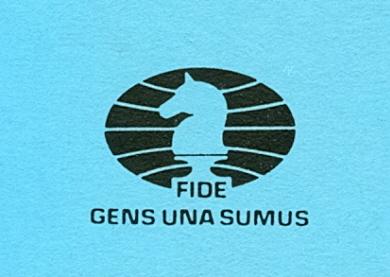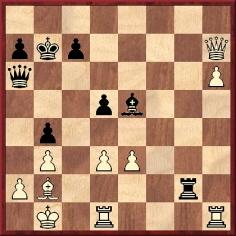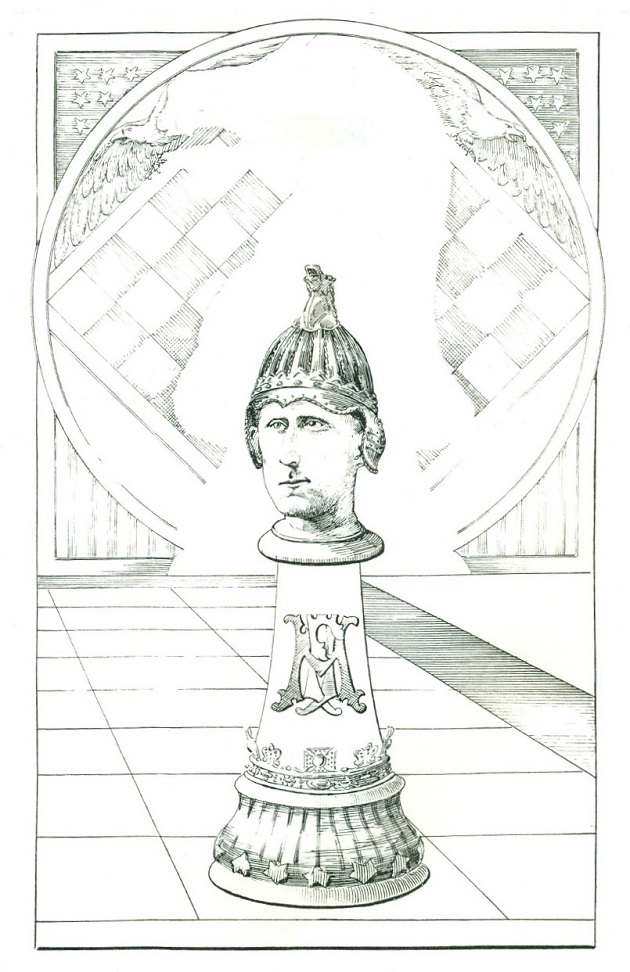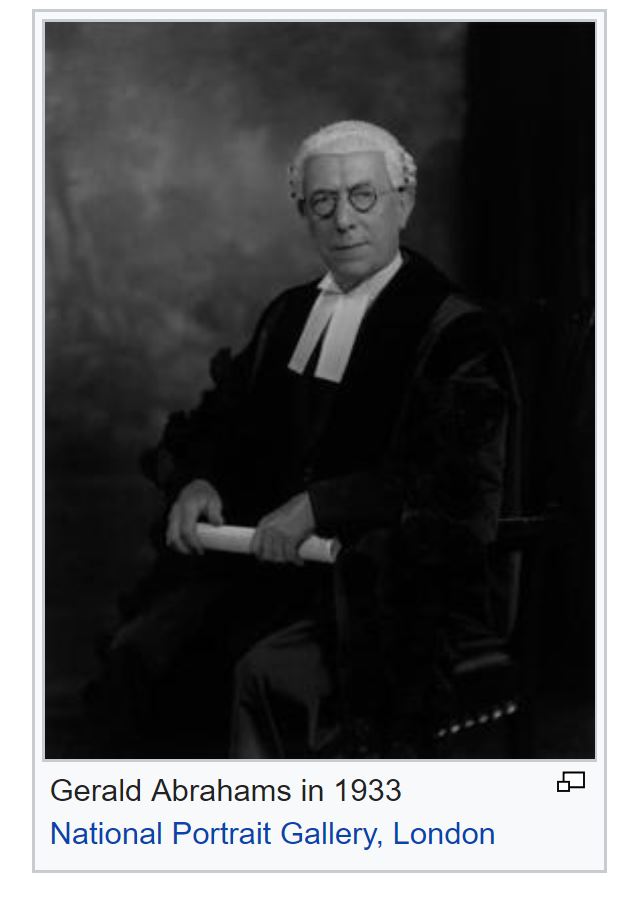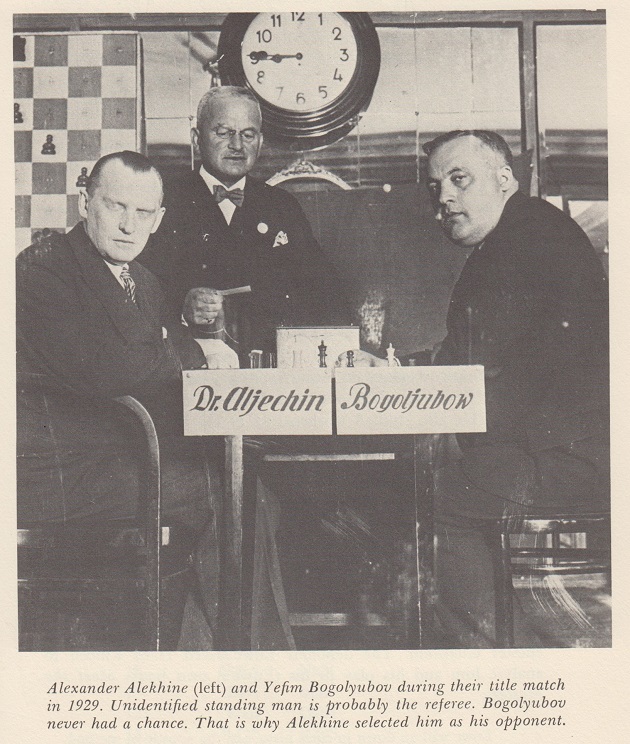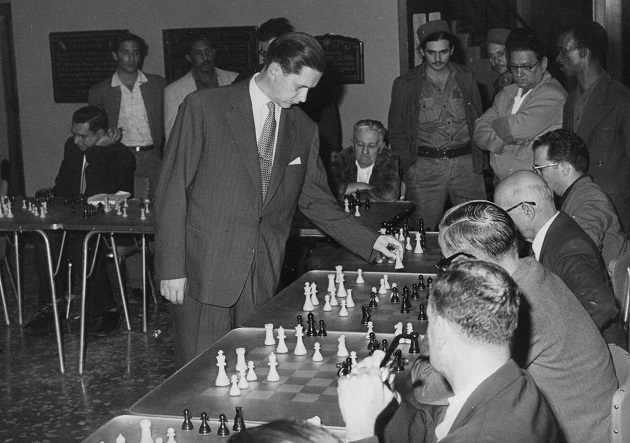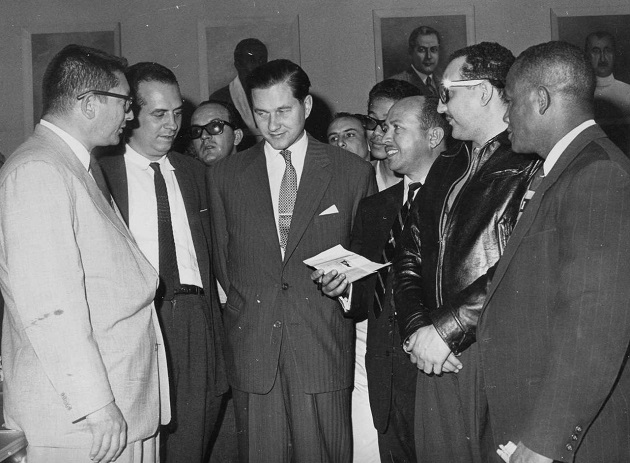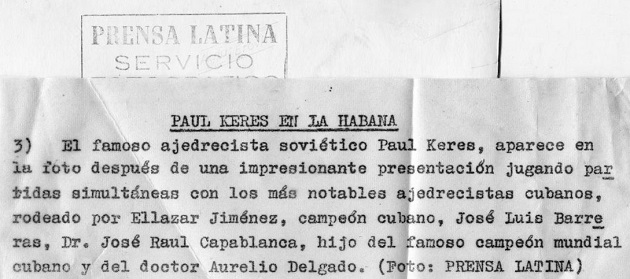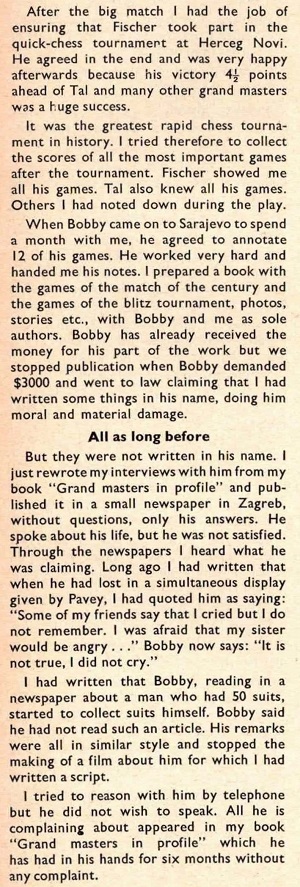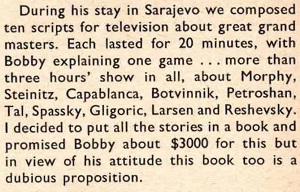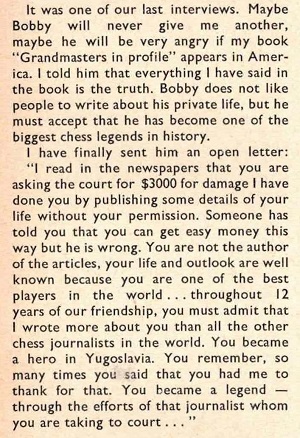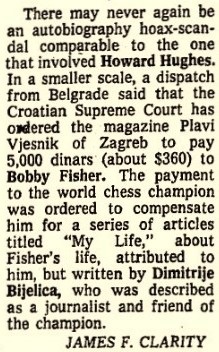12082. When
did Steinitz become world champion?
Bartlomiej Macieja (Lasek, Poland) refers to the
feature articles Early
Uses
of ‘World Chess Champion’ and World
Chess
Championship Rules and draws attention to a
further text, published a few days before the first
Steinitz v Lasker match began. Page 24
of the New York Times, 11 March 1894 stated:
‘For 26 years the veteran has successfully
defended the championship of the world.’
Also:
‘If a man who has held the world’s championship
for 26 years accepts a challenge for a match which
promises to him less remuneration than matches he
contested before, he deserves some praise.’
The illustrated article was also published, with
due credit, on page 3 of the Montreal Daily
Witness, 13 March 1894.
Nineteenth-century references to the duration of
Steinitz’s tenure are always welcome, regardless of
the view adopted.
12083.
‘Tournament champion’
Shortly before the start of the Carlsbad, 1907
tournament, Emanuel Lasker wrote on page 10 of the
New York Evening Post, 7 August 1907:
‘The only notable absentee is Dr Tarrasch, who
has been hailed as “tournament champion” since he
won the “champions’ tournament” at Ostend. What
title will be conferred on the winner of this
tournament [Carlsbad] is rather puzzling at
present.
As the list of entries includes all those who
played in the “champions’ tournament”, with the
exception of Dr Tarrasch, and includes Maróczy and
many of the ingenious young players who are coming
to the front, the Carlsbad tournament must be
considered to be of the same class as that of
Ostend, and it seems illogical to award the title
of “champion” to the winner of one tournament and
withhold it from the winner of the other.’
12084.
Cohn v Chigorin
Many books have the game between E. Cohn and
Chigorin, Carlsbad, 1907, for which White shared the
second brilliancy prize. Much has been written about
11 f4, a move upon which Emanuel Lasker remarked:
‘Mr Cohn frankly admitted that he did not see
that he would lose a pawn by this move. That it
turns out a “sacrifice”, and not a loss, is more
good luck than good management.’
Lasker gave the game on page 9 of 12 October 1907
edition of the New York Evening Post, and
his comments about the ‘Irregular Opening’ are
noteworthy:
1 d4 Nf6 2 c4 d6 3 Nc3 Nbd7 4 e4
‘Players like Chigorin undoubtedly dread the
usual routine of the queen’s pawn opening, because
of the difficulty which, as Black, they must
experience before they can hope to attain any kind
of attack or superiority. By some curious process
of reasoning they resort to outlandish manoeuvres,
hoping that something beneficial might turn up, or
that irregularity may help originality. And so
this position arises, where White has freedom and
Black confinement. And this at no cost to White of
material or weakness on the right, left or centre
of the board. Conceding such an advantage, the
result is inevitable against correct play. The
queen’s pawn opening is certainly very strong for
White, as indeed are many other openings. But the
philosophy which induces a player with the black
pieces to hope to win with moves which it is
impossible to conceive are the best available only
increases the inherent difficulties that have to
be contended against.’
12085.
Mexico
Is there a reader in Mexico who has access to
archival materials of the country and who would be
prepared to undertake some chess research on behalf
of a C.N. correspondent?
12086.
Anti-Turton
White to move
1 d4 would be met by 1...Qe2, and White therefore
deployed the anti-Turton
motif with 1 Rd2. A correspondent gave this position
(Lucarelli v Carra, Bologna, 1932 or 1933) in C.N.
681, but further particulars (and most notably the
full game-score) have not been traced. The two
surnames can be found in Italian chess literature of
about a century ago (often, in the second case, with
the spelling Carrà), but when was the position, if
not the full game, first seen in print?
Jens Askgaard (Køge, Denmark) writes:
‘The position from the game Lucarelli-Carra
appears on page 109 of Schackkavalkad by
Kurt Richter (Stockholm, 1949), translated from
the original Kurzgeschichten um
Schachfiguren (Berlin, 1947):
The date is given as 1933. Instead of Black
resigning after 1 Rd2 Rxd2 2 d4 Qe2 3 Bc1, the
book says that White won easily thanks to his
strong passed pawn on h6.
I would add that 2...Qe2 is a losing mistake
for Black. Instead, he could have played the
anti-anti-Turton move 2...Rf2, or 2...Bh2, which
my computer suggests as the best move.’
The position was on page 101 of the 1947 original
edition. Had Richter already used it elsewhere?
12087.
Ordinal numbers (C.N. 12033)
C.N. 12033 asked when and where the practice arose
of referring to world chess champions with ordinal
numbers.
From Dmitriy Komendenko (St Petersburg, Russia):
‘In Soviet sources I have found no instances
of Botvinnik being called “the sixth world
champion” during his first term (1948-51),
although quite often he was called “the first
Soviet champion”. The description “sixth world
champion” can be found in articles published in
1951 in advance of his match against Bronstein,
one example being a summary of the history of
the chess matches on page 5 of the 15 March 1951
edition of the newspaper Советский спорт:
Frequent use of ordinal numbers seems to have
begun with Smyslov. For instance, in an article on
page 31 of the 16/1957 issue of Огонёк
Flohr wrote, “Smyslov wants to be the seventh
champion of the world in chess history”.
Other examples from 1957 can be quoted, such
as the 19/1957 edition of Огонёк, page 31,
where the writer, again Flohr, called for three
times hurrah to celebrate the new, seventh world
champion:
Starting with Tal, the practice became
increasingly common. On page 3 of Советский
спорт, 11 May 1960 an article by Gideon
Ståhlberg, who was the chief arbiter of that
year’s title match, was headed “The eighth world
champion”:

A production by the Central Studio for
Documentary Film (ЦСДФ) had the same
title with reference to Tal. The tradition
had been established and continued with
Petrosian, Spassky, Fischer, etc.’
12088.
Robert Hübner (1948-2025)
The late Robert Hübner’s great strength as a player
and analyst should not cause his legacy as a chess
historian and critic to be overlooked. The C.N.
search window can be used to locate a number of
items which refer to his forensic skills.
12089. The
writings of Robert Hübner
In his ChessBase ‘Two
Knights
Talk’ conversation with Arne Kähler on 17
January 2025, Johannes Fischer described Hübner as
‘an absolutely brilliant writer’ and expressed
astonishment that so little of his output has
appeared in English.
12090.
Keres v Alexander
This photograph of Paul Keres and C.H.O’D.
Alexander is reproduced courtesy of the Hulton
Archive. It was taken during Hastings, 1954-55, but
the board position is unrelated to their game in the
tournament.
12091.
Staunton and Saint-Amant
As cited in C.N. 8134, G.H. Diggle’s review of The
Kings of Chess by William
Hartston noted the inclusion of a cartoon
depicting ‘Staunton’s final victory over
Saint-Amant, with his supporters singing the
National Anthem in the background’.
Dominique Thimognier (Fondettes, France) draws
attention to the cartoon’s appearance on page 151 of
Les Cahiers de l’Echiquier Français, issue
49, September-October 1935:
Our correspondent adds:
‘La Revue Caricaturale published the
work of major French caricaturists, including
the celebrated Honoré Daumier. The chess
cartoon, by Charles Vernier, appeared in the 5
January 1844 edition. It is shown on the
Bordeaux website Séléné,
although with a notice which appears incorrect
regarding the place of first publication (not
Bordeaux but Paris).’
12092.
Howard L. Dolde
Source: the conclusion of Chernev’s Chess Corner on
page 237 of Chess Review, August 1952.
Such presentation of quotes, lacking any context
(e.g. Capablanca’s age at the time, and whether the
words were written or spoken), was a trait of past
chess writers, even good ones. Today, the absence of
a source leaves any writer open to scepticism.
Capablanca’s remark was discussed on pages 85-86 of
our 1989 monograph, as well as in C.N.s 6172 and
9630. Below is the full (faint) column in which it
first appeared, on page 8 of the sixth section of
the Pittsburgh Gazette Times, 7 May 1916:
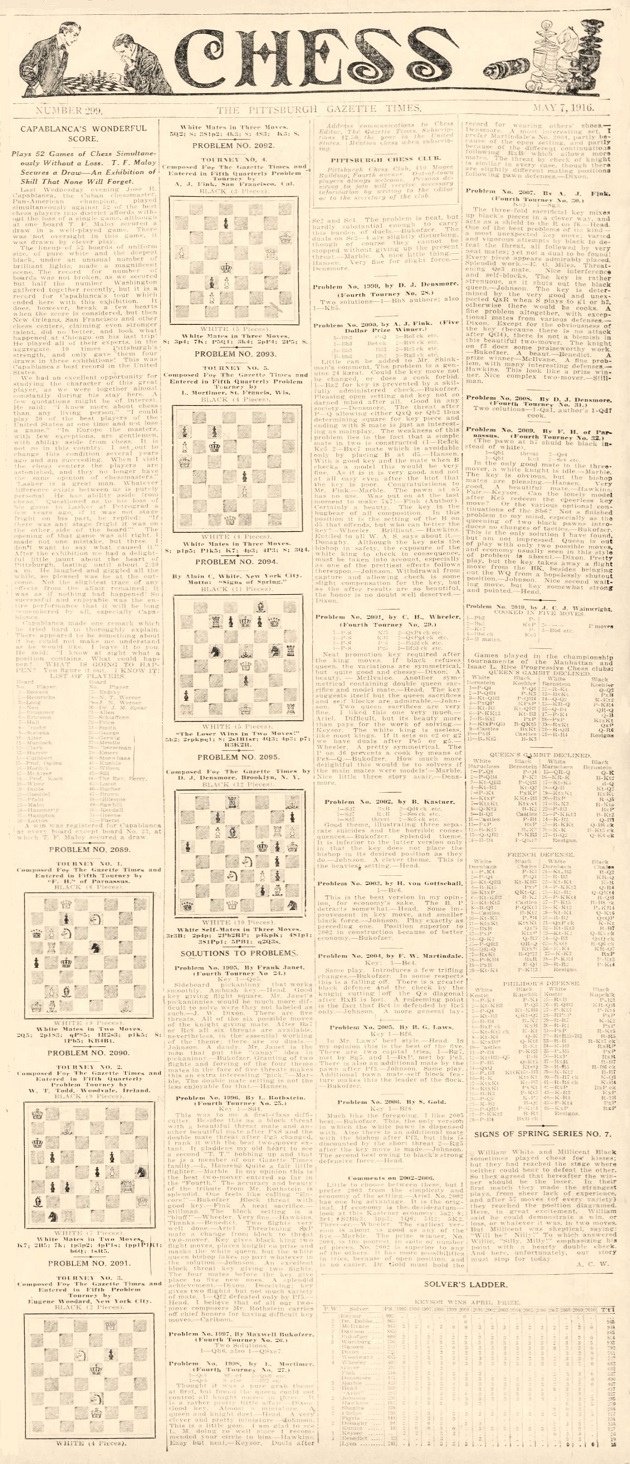
Larger
version
The columnist, who focussed very much on chess
problems, was Howard Louis Dolde (1884-1943).
From page 6 of the Pittsburgh Post-Gazette,
7 September 1943:
We note too that the previous day, page 17 of the
newspaper had referred to a coroner’s report on the
cause of death:
For other information on Dolde, see an article by
Neil Brennen on pages 276-287 of the 8/2002 Quarterly
for Chess History.
Addition on 23 January 2025:
Courtesy of the Cleveland Public Library, below is
an extract from page 82 of the April 1910 American
Chess Bulletin:
12093.
The death of T.W. Barnes
John Townsend (Wokingham, England) writes:
‘Thomas Wilson Barnes had the best record of
any of the British players against Morphy in
offhand games. Born in Ireland about 1825
(source: 1871 census), he qualified as a
barrister at the Middle Temple, but was
non-practising for a number of years.
Like Deschapelles, as well as being an
exceptionally strong chessplayer he excelled at
whist. When Barnes led trumps, the game was
over, said an obituary.
The same obituary (“Whist Jottings”, Westminster
Papers, 1 September 1874, pages 99-100)
described in detail the symptoms of his last
illness:
“His illness has been a long and painful one.
This time last year he weighed 16 stones; he
went abroad and his strength seemed suddenly to
leave him. With difficulty he got into a cab. He
gradually wasted away, until he became 7 st. 8
lb., and this was the last time he was weighed
(two months since), and he was certainly much
less weight at the last. Physicians were in
vain. No one really knows the cause of his
death; some have suspected a cancer in the
stomach, and, unfortunately, he would not give
permission to have a post mortem, so that the
real cause will remain a matter of surmise. Our
impression is that he died from ‘banting’. From
being an enormous eater he suddenly stopped his
food, taking meat only once a week; and soon,
from want of use, his stomach refused to fulfil
its functions. He died in peace, and desired
kind remembrances to all his friends. To us his
last words were whispered, ‘Kind, kind to the
last; God bless your wife and little ones’. He
lost his voice ten days before his death, and
for 12 days he ate nothing ...”
“Banting” was a low carbohydrate diet system,
named after its originator, William Banting.
A transcript of Barnes’ death certificate
follows:
“When and where died: 20 August 1874, 68
Cambridge Street
Name and surname: Thomas Wilson Barnes
Sex: Male
Age: 49 years
Rank or profession: Barrister at Law
Cause of death: ‘Malignant disease of the
Stomach some months Certified’
Signature, description and residence of
informant:
Jane Simpson Present at the Death Madden Rectory
Armagh Ireland
When registered: Twenty second August 1874
Signature of registrar: WP Griffith (?)
Registrar”
Source: General Register Office, Deaths, Sept.
quarter 1874, St George
Hanover Square, Vol. 1A, page 225)”
The cause of death, “Malignant disease of the
Stomach some months Certified”, seems, to a
medical layman such as myself, to account for
the symptoms of rapid weight loss which have
been alleged by some to be the result of
“banting”.
The Calendar of Wills and Administrations
(Dublin) for the year 1874 contains the
following entry:
“Barnes Thomas Wilson
Effects under £5,000
15 October
The will of Thomas Wilson Barnes late of Middle
Temple and 68 Cambridge Street London
Barrister-at-Law deceased who died 13 August
1874 at 68 Cambridge Street was proved at the
Principal Registry by the oaths of Reverend
Samuel Simpson of Derrynoose Rectory County
Armagh Clerk and Alexander Duke Simpson of
Belfast Captain 13th Foot two of the Executors.”
Although there is the above entry in the
calendar, the actual will has not survived,
owing to a fire in Dublin in 1922.
For some reason, the date of death given above
is one week earlier than that contained in the
death certificate.
Barnes was buried in Brompton Cemetery on 25
August 1874. Source: the Royal
Parks website.’
12094.
S.S. Boden
John Townsend also provides ‘some random notes on
the life of S.S. Boden’:
‘Samuel Standidge Boden was born on 4 May 1826
at West Retford, Nottinghamshire. Although some
sources, including the Oxford Companion to
Chess, have specified East Retford, the place
of birth is clear in his baptism entry in the
register of the independent chapel at Chapel
Gate, East Retford (source: National Archives,
RG 4 /3217, folio 7):
“Samuel Standidge, son of James and Mary
Frances Boden, was born 4th of May 1826 in the
parish of West Retford, and baptized July 27th
in the same year. Jas. Boden.”
The chapel was nonconformist, and the
officiating minister was his father, James
Boden, whose father, in turn, James Boden, was a
well-known Congregationalist minister at
Sheffield and elsewhere.
James Boden junior was baptized on 28 August
1791 at Hanley Tabernacle, Staffordshire, an
independent chapel (National Archives, RG
4/1871). He preached at Retford for a few years
before moving with his work, and the 1841 census
shows him as an Independent Minister, together
with his family, including the 14-year-old
Samuel, at “Riding Fields”, Beverley (National
Archives, HO 107 1229/43, page 44).
Later that year, James Boden senior died. His
will styled him “Reverend James Boden, Minister
of the Gospel, of Sheffield” (National Archives,
PROB 11/1953/196). James Boden junior was named
as a legatee, but not the future chessplayer,
Samuel, who was a grandson.
The loss at Chesterfield of Charlotte Boden,
widow of the elder James, followed on quickly in
1843. James Boden junior, father of Samuel, had
lost both parents within two years. During 1843
and 1844, he was mentioned a few times in the
local press in connection with a chapel in
Beverley and with the Mechanics’ Institute. The
last reference I have to his duties as a
minister in Beverley is a document noted in the
catalogue of the archives at Hull History
Centre, L DCFS/6/2/2/59/3: “Resolutions
concerning the employment of Mr Boden at
Lairgate Chapel during the illness of Rev. John
Mather”, dated 1843, an item which I have not
examined.
The Hull Advertiser, 24 November 1843,
page 4, carried a news item about the Mechanics’
Institute, Beverley, in which he is recorded as
having proposed a vote of thanks. Similarly,
there is a reference to him in the Hull
Advertiser, 8 March 1844, page 3, when he was
reported as having delivered a lecture on
magnetism to the Beverley and East Riding
Mechanics’ Institute, of which he was one of the
vice-presidents. Thereafter, I have no more
information about James Boden until his death in
1851.
His wife, Mary Frances Boden, moved to Hull,
her native town, with or without her husband.
Rev. William Wayte, writing in the BCM
(February 1882, page 56), affirmed Samuel
Boden’s association with Hull:
“Before he came to London, Mr Boden was known
as the strongest player of the Hull Chess Club”;
Some chess writers erroneously gave Hull as
Boden’s birthplace.
An obituary of Samuel Boden in the Chess
Player’s Chronicle (18 January 1882, page 31)
notes that he started life as a railway clerk
and it later makes the following observation:
“On coming into some property, through the
death of a relative, he devoted himself to art.
This necessarily left him but little time for
chess and its practice.”
The Westminster Papers (1 September
1876, page 89) states:
“About 27 years ago there came to London from
Hull a young gentleman, then 25 years of age,
whose immediate destiny was a desk in the
offices of the South Eastern Railway at Nine
Elms.”
There seems to be an inconsistency in this
last remark, since Nine Elms was in the South
Western Railway Company. A document noted in the
catalogue of the National Archives, RAIL
411/665, offers the possibility of some
information concerning Boden’s railway career
among records of the staff of Nine Elms. The
document has not yet been examined.
Later in the Westminster Papers
article, it is asserted that “the death of a
distant relative some years ago” enabled him to
“relinquish railway accounting”.
The known sources of his inheritances through
the deaths of relatives were twofold. Firstly,
his maternal grandfather, John Thornton, a
gentleman, died in Hull in 1845, leaving a will
which was written on 20 August 1844, a codicil
being added on 29 July 1845, with probate
granted on 28 August 1845 (National Archives,
PROB 11/2027/205). The dwelling house at the
time of the testator’s decease was given to his
daughter (Boden’s mother) during her life:
“ ... upon trust to permit my said daughter
Mary Frances Boden to have the use and enjoyment
thereof during her life exclusively of her
present or any future husband and without being
in any manner subjct to his debts control
interference and in all respects as if she was a
feme sole and after her decease I direct
the same to sink into and be considered as part
of my residuary personal estate and to be
applied and disposed of accordingly ...”
She received a lifetime interest in other
properties. The will mentions property in Hull,
including in Albion Street and Storey Street.
S.S. Boden was not one of the biggest winners
from this will, but he stood to benefit in the
long term through his mother, whom, in the
event, he outlived by only three years. In
addition, a trust fund was set up for the
benefit of his mother and her children, and,
more specifically, he was given a lump sum of
£400 at the age of 21:
“... upon trust to pay thereout to each of the
sons of my said daughter Mary Frances Boden
(including the said John Thornton Boden and
Edward Boden) who may have attained the age of
21 years or as and when they shall respectively
attain that age the sum of four hundred pounds
...”
The date of Boden’s coming of age was 4 May
1847, but it is open to question whether he gave
up his alleged job as a railway employee shortly
after coming of age.
The second known inheritance came not from “a
distant relative”, but from his father. The
following facts are taken from his death
certificate (General Register Office, Deaths,
December quarter 1851, Shoreditch, Vol. 2, page
327). James Boden died on 8 December 1851 at 11
Albert Place, Shepherdess Walk, Hoxton New Town
(Middlesex); male, 62 years, gentleman; cause of
death: “Typhoid Fever Peritonitis Pleuritis
Pneumonia Gangrine, 24 Days Certified”;
informant George Booth, present at the death, of
the same address; registered 10 December 1851.
George Booth was already living at 11 Albert
Place on 31 March 1851, the day of the 1851
census, where he was described as a watch
finisher; aged 37 and born in the City of
London, he lived there with his wife, Louisa,
and two children (National Archives, HO
107/1535, page number illegible). The nature of
his relationship with the deceased, James Boden,
is unknown.
James Boden was buried at the church of St
John the Baptist, Hoxton, on 11 December, the
officiating minister, by whom the ceremony was
performed, being his own son, Edward Boden, of
Huddersfield. The 1851 census finds Edward Boden
in Huddersfield, described as born at Retford,
aged 28, “B.A. Camb. Vice-Principal” of the
Collegiate School there (National Archives, HO
107/2295, page 41). A minor discrepancy between
the age of 61 in the burial register and of 62
on the death certificate is of no consequence.
The Huddersfield Chronicle (20
December 1851, page 8) reported that “on
Thursday morning last” at the distribution of
prizes at the Collegiate School “the Rev. Mr
Boden was unavoidably absent, having been called
to Ripon by the bishop to take priests’ orders”.
It seems a little odd that the report made no
mention of his having presided at his father’s
burial, or, indeed, of the death of a minister
who was formerly a widely-known figure in
Yorkshire church circles. When James Boden
senior had died, there had been an insertion in
Gentleman’s Magazine, as there had been for
his widow, Charlotte Boden.
James Boden died without a valid will, and,
accordingly, letters of administration were
granted in the Prerogative Court of Canterbury
to Samuel S. Boden, of Thavie’s Inn (source:
Indexes to death duty registers, National
Archives, IR27/60, folio 14). The assets of an
intestate are divided between the closest
relatives according to set rules; in this
instance, one would expect the widow to receive
the lion’s share, with smaller portions going to
the several children. For those requiring full
details of the assets thus inherited by Boden
the chessplayer, inspection of the appropriate
death duty register in IR 26 at the National
Archives at Kew should satisfy their curiosity;
the letters of administration will be found in
PROB 6.
Boden’s residence for a number of years,
Thavie’s Inn, situated at Holborn, was
originally used exclusively by lawyers, but by
this time was available as accommodation for
anyone willing to pay the going price. In fact,
S.S. Boden is to be found there at the time of
the 1851 census (National Archives, HO 107/1527,
page 36). He lived in a boarding house run by
Anne Cocker, a 53-year-old single woman, born at
Hathersage, Derbyshire. Through an error in
enumeration, Boden’s name has been recorded as
“Samuel S. Bax”, but other details make it
obvious that it should read “Samuel S. Boden”:
he is described as a boarder, unmarried, aged
24, a gentleman, born at Retford, Notts.; above
all, corroboration is provided by the “Thavie’s
Inn” which appears in the indexes to death duty
registers (see above); moreover, Boden was
associated with Thavie’s Inn during Morphy’s
time in England, viz.:
“We have the pleasure this month of completing
the publication of the series of games contested
in 1858 between Mr Morphy and Mr Boden. The
following game, hitherto unpublished, was played
between these eminent masters, at Mr Boden’s
Chambers, in Thavie’s Inn, on the evening of 9
July 1858. The Rev. S.W. Earnshaw, to whom we
are indebted for it, was present on the
occasion, and recorded the moves.”
(Source: the Westminster Papers, 1
April 1876, page 241.)
Spare a thought for Boden’s father. What
happened to him? He became detached from his
wife and the rest of his family, and his death
in 1851 was hushed up, suggesting that his
family was not proud of him. Since he died in
Hoxton, my first thought was that he may have
spent some time in the lunatic asylum at Hoxton,
but I have so far found no evidence of that. He
may have had a change of career, a marital
break-up, moved to another area, become an
insolvent debtor, or become ill in some other
way. Various possibilities remain open.
G.A. MacDonnell quotes Boden as recalling when
he first met Bird at the Divan in the Strand, in
The Knights and Kings of Chess, (London,
1894), page 44. That implies that Boden had
himself started to visit there by 1846.
In 1847 Hull hosted the anniversary of the
Yorkshire Chess Association (Chess Player’s
Chronicle, 1847, pages 159-164). In fact, two
Bodens attended: “Mr Boden, from Settle”,
presumably, John Thornton Boden, elder brother
of S.S. Boden, and “Boden”, by inference a Hull
member, who is taken to be S.S. Boden himself.
He won a game there from Harrwitz, who was
playing blindfold and simultaneously, which
earned him this favourable comment from
Staunton:
“ ... Mr Boden, one of the most promising
players of the Northern clubs.”
Boden took a number of years to come to his
best as a player, his peak arriving in 1858. In
1851, he won the London “Provincial” tournament.
He beat Rev. John Owen convincingly in a match
in 1858, but his match play successes were
otherwise limited. His reputation seems to have
exceeded his actual achievements. Morphy’s
description of him in 1858 as the strongest
English player can be valid only if one excludes
Löwenthal on the grounds that he was not
naturalized until 1866, and Staunton, because he
had retired, since it could be argued that both
were stronger than Boden in 1858.
By the time of the 1861 census, he had moved
to 57 Pratt Street in the parish of St Pancras
(National Archives, RG 9/116, page 64). Here he
was a bachelor and lodger and described as an
“artist (landscape)”. Also living in St Pancras
at that time was the Irish master Francis
Burden, who for a time lodged with Cecil De
Vere’s mother. The two of them are both
associated with having given the young De Vere
instruction in chess, but it is not known that
Boden ever lodged with Mrs De Vere, and he
probably coached De Vere at the Divan.
His later years were occupied primarily by
art. His whereabouts on the 1871 and 1881
censuses remain to be discovered. He died on 13
January 1882, at 3 Tavistock Street, Bedford
Square, Middlesex, described as “artist
(painter)”, his age entered (incorrectly) as 56
(General Register Office, Deaths, March quarter
1882, St Giles district, volume 1B, page 453).
His name was entered incorrectly as “Samuel
Standridge Boden”, instead of Standidge. The
cause of death was “Enteric Fever 20 days
Pneumonia 4 days Certified by Charles Elam
F.R.C.P.”, the informant being Joseph Wurgler,
present at the death, of 3 Tavistock Street. In
the 1881 census, Joseph Wurgler was a Swiss-born
lodging house keeper, living at that same
address with his wife and daughter (National
Archives, RG 11 325, page 15), so he is taken to
have been Boden’s landlord. According to the
National Probate Calendar, Boden’s personal
estate amounted to £2,628 2s., probate of his
will being granted on 14 April to the executors,
his brother Reverend Edward Boden and the
chessplayer Thomas Hewitt, a solicitor.’
12095.
A bishop ending
From pages 51-52 of the January-February 1907 Wiener
Schachzeitung:
The position was picked up by the BCM
(November 1907, page 489) ...
... and, with great enthusiasm, by Emanuel Lasker
in his New York Evening Post column, 18
December 1907, page 6:
12096. The
Monrad system
Carl Fredrik Johansson (Stockholm) enquires about
the origins of the Monrad pairing system, and we
offer some initial jottings.
An article by K.D. Monrad entitled ‘Et nyt
Turneringssystem’ (A New Tournament System)
was published on pages 40-41 of the April 1925 issue
of the Danish magazine Skakbladet, with a
follow-up article by him on page 81 of the July 1925
edition. There was extensive discussion of the
system in Norsk Schakblad, beginning on
pages 130-132 of the September 1925 number
(contributions by Erling Wold and O. Trygve Dalseg)
and continuing in December 1925, pages 180-181
(Erling Wold) and January-February 1926, page 13 (O.
Trygve Dalseg).
All the above material can be conveniently viewed
online: see Skakbladet
and Norsk
Schakblad.
About K.D. Monrad, further information will follow,
with readers’ assistance. For the time being, we
note a reference on page 102 of the 6/1981 Skakbladet:
12097.
A worthy opponent
From Norsk Schakblad, March 1925, page 37:
Acknowledgement:
Cleveland Public Library
For other examples of this technique, see C.N.s
3221, 3224 and 6040 in Chess
Jottings.
12098.
Lasker on the Ruy López
Firstly, the text of C.N. 3058 (given on pages
325-326 of Chess Facts and Fables):
‘If you have Black, and your opponent plays 3
Bb5, your best move is to offer him a draw.’
This remark by Emanuel Lasker appeared in the Boston
Transcript of 31 January 1903, an item
quoted on page 130 of the March 1903 Checkmate.
The Boston newspaper commented:
‘And although this was a bit of pleasantry, Dr
Lasker did say in all seriousness that where the
second player in almost any other opening might
hope for a win, it was good judgment in the Ruy
to hope for a draw. The suggestion that the
chess world was waiting for some man who should
begin an exhaustive analysis of the Ruy early
enough in life to complete it, he dismissed with
a deprecatory shrug. “I’m afraid he would have
to continue it in the hereafter”, he said.’
We have wanted to verify the Checkmate
passage in the Boston newspaper and to add the page
number, but so far only a similar, not identical,
text has been found, on page 1 of the Boston
Evening Transcript, 2 February 1903:
12099.
Simultaneous displays by Lasker
By way of introduction to the now familiar
simultaneous game F.W. Dunn v Emanuel Lasker,
London, 21 January 1908, which began 1 e4 e5 2 Nf3
Nc6 3 Bc4 Nf6 4 Ng5 d5 5 exd5 Nd4, Lasker’s column
on page 7 of the New York Evening Post, 28
March 1908 stated:
‘Simultaneous chess, which has now become so
popular, both here and in Europe, is capable of
furnishing entertainments and instruction to the
amateur chessplayer. But in order to make it so,
it is necessary that the single performer –
usually a master – should consider the interests
of his opponents, and instead of measuring his
success by the high score he can make, he should
endeavor to play all sorts of combinations,
calculated to exercise the ingenuity of his
spectators. One should not try to play perfect
chess on such occasions, for, to begin with, under
the condition of play, one cannot succeed in doing
so and, on the other hand, by introducing
novelties that may lead to lively, though perhaps
unsound, attacks, one not only avoids unduly
prolonging the performance but also presents to
the spectators many interesting and exciting
positions. This sort of simultaneous chess also
appeals to the opposing players, who usually
prefer being defeated in a fair fight rather than
being gradually and dismally ground down by the
proverbial pawn plus.
Dr Lasker’s popularity as a simultaneous
performer is largely due to his following this
method of procedure. Always endeavoring to make
his exhibitions both entertaining and instructive,
he rarely follows the orthodox lines of play, but
by varying at some point endeavors to create
interesting situations that shall throw his
opponents [sic] on his own resources, and
enable him to exercise his ingenuity in finding
the best reply.’
A comprehensive
chronicle of his simultaneous displays from
1893 to 1940 is provided on the Emanuel
Lasker Online website.
12100. The
three shortest ever chess book reviews
Two
words.
One
word.
No
words.
12101.
Wallace, Liverpool and Rubinstein
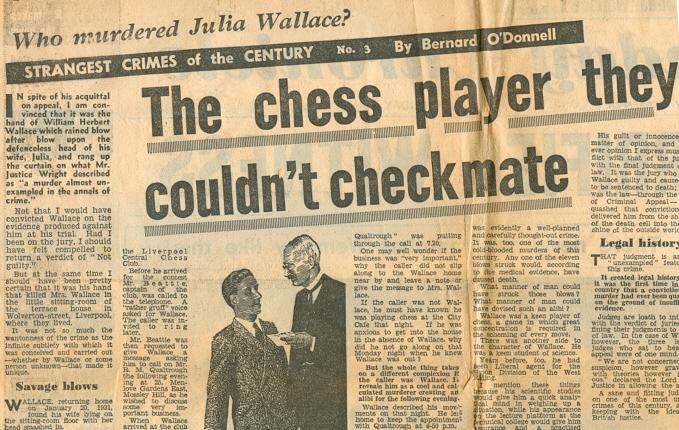
Any chess-related information about William Herbert
Wallace (1878-1933) and the Wallace
Murder
Case is of interest, and here we show a number
of local newspaper cuttings from the time when he
was a member of the Central Chess Club in Liverpool.
From the Liverpool Post & Mercury, 27
February 1930, page 14:
Five years previously, Akiba
Rubinstein had visited the city for a series
of chess engagements. As marked in red below, two of
the newspaper reports, on 27 February and 6 March,
included the name Wallace:
Evening Express
(Liverpool), 20 February 1925, page 6
Liverpool Post
& Mercury, 25 February 1925, page 10
Liverpool Echo,
25 February 1925, page 7
Liverpool Post
& Mercury, 26 February 1925, page 11
Liverpool Post
& Mercury, 27 February 1925, page 13
Liverpool Post
& Mercury, 28 February 1925, page 9
Liverpool Post
& Mercury, 28 February 1925, page 11
Liverpool Post
& Mercury, 6 March 1925, page 10.
12102.
Duchamp and Le Lionnais
From Oliver Beck (Seattle, WA, USA):
‘I have come across an article written by
Raymond Keene entitled “Chips with a pinch of
salt: Duchamp and Le Lionnais” which appeared
online in The Article (thearticle.com), dated 7
December 2024. It contains material taken from
C.N. 9465 with no mention of you or Chess Notes.
However, Mr Keene did credit me with at least
some of it, describing me as “the late Oliver
Beck of Seattle”.’
12103.
Backgammon
From page 2 of the Brooklyn Daily Eagle, 10
March 1930:
12104.
Quote-pruning
C.N. 3212 quoted William Hartston’s exact words
about A History of Chess, on page 189 of The
Kings of Chess (London, 1985):
‘The classic book on the subject; 900 pages of
meticulous research, practically unreadable.’
12105.
The Real Paul Morphy (C.N. 12018)
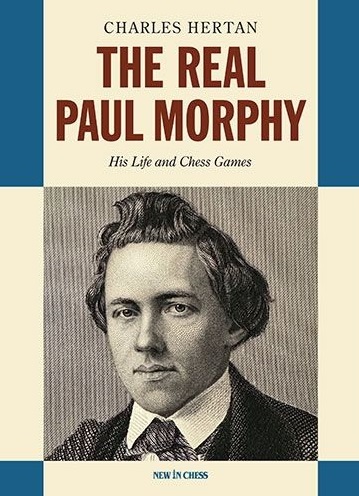
From John Townsend (Wokingham, England):
‘Pages 268-272 of psychotherapist Charles
Hertan’s recent book The Real Paul Morphy:
His Life and Chess Games (Alkmaar, 2024)
contain material about the Staunton-Morphy
controversy. For those needing a reminder, the
controversy can be seen as comprising the
following phases in 1858:
1. Morphy arrives in England and challenges
Staunton to a match. The latter, who has
retired from match play, accepts, but points
out that he is under contract to produce an
edition of Shakespeare’s works, and he needs
time to brush up on his game.
2. Relations between the two belligerents
deteriorate through unfriendly exchanges in
the press and elsewhere.
3. At length, Staunton withdraws from the
negotiations. Relations continue to be bad and
never really improve.
I did not notice new information about the
controversy in this part of the book, or signs
of fresh research on the topic. Much of the
content in those pages is concerned with the
quoting of contemporary reports and documents
which have appeared in print before. For good
measure, the author treats us to some colourful
remarks of his own which reveal a one-sided
stance in favour of Morphy.
Treatment of the Staunton-Morphy controversy
in Chess Notes, going back to the 1980s, has
included contributions from, among others, Louis
Blair, G.H. Diggle, Frank Skoff and Kenneth
Whyld, and the quartet of feature articles below
includes many lively exchanges:
Edge,
Morphy
and Staunton
A
Debate on Staunton, Morphy and Edge
Supplement
to
‘A Debate on Staunton, Morphy and Edge’
Edge
Letters
to Fiske.
The C.N. discussions have been conducted in an
editorially impartial and even-handed manner,
but it seems that even-handedness was not part
of Mr Hertan’s objectives. He refers to Morphy
sometimes as “Paul”, while the supposed villain
of the piece has to make do with “Staunton”.
The following anti-Staunton language and
sentiment is to be found:
Page 268:
“Paul understandably doubted Staunton’s
intentions”
“... sucker punches received from Staunton in
the press ...”
“... Morphy shared his concern that Staunton
would try to evade the match, and pin the
blame on Paul ...”
Page 270:
“... but Staunton being Staunton, he couldn’t
resist taking more cheap shots at Morphy in
his column ...”
“... his shoddy treatment of the American
...”
Page 271:
“These actions were certainly petty and
ungracious on Staunton’s part”
“... the bitchy sniping of a humiliated
champion ...”
“... potshots at Morphy ...”
“... rattled by Staunton’s antics ...”
“... his unseemly behavior ...”
Page 272:
“... Staunton’s catty, distasteful behavior
...”
“But Staunton’s defenders never threw in the
towel.”
Page 273:
“Howard Staunton had a deeply flawed
personality.”
This last remark is perhaps the most damning
of these criticisms and is stated with the same
certainty as if Mr Hertan had had Staunton on
the psychiatrist’s (or psychotherapist’s) couch
in his consulting-room. It almost reaches the
level of conviction of Dale Brandreth, whom you
quoted in Attacks
on Howard Staunton:
“… the fact is that the British have always had
their ‘thing’ about Morphy. They just can’t seem
to accept that Staunton was an unmitigated
bastard in his treatment of Morphy because he
knew damned well he could never have made any
decent showing against him in a match.”
Reference is made by Mr Hertan to the old
criticism that Staunton unfairly accused Morphy
of not having the stakes for the match. The
latter was hurt by the comments. Staunton had
had difficulties in the past with would-be match
opponents who could not readily muster the
stakes, an example being Daniel Harrwitz. He did
not invent the problem of Morphy’s stakes. In
his book Paul Morphy The Pride and Sorrow
of Chess (New York, 1976) David Lawson devotes
a chapter to the subject of Staunton and the
stakes, which reveals that Morphy’s family, the
intended source of the stakes, strongly
disapproved of a match for money. It is only too
clear from Charles Maurian’s letter of 27 July
1858 to D.W. Fiske that the family’s attitude
most certainly was a problem which seriously
threatened the match. Morphy had kept from
Maurian the extent of this disapproval and the
extraordinary lengths the family was prepared to
go to, which Maurian now revealed:
“... they were ready to send some responsible
agent to London whose duty it would be to let Mr
Morphy know that he must either decline playing
or continuing the match or that he will be
brought home by force if necessary; that they
were determined to prevent a money match by all
means.” (Lawson, pages 120-121)
Hinc illae lacrimae. Clearly, this ruled out
the family as the supplier of the stakes. It
left poor Maurian close to his wits’ end.
Fortunately, he acted promptly and, in a change
of plan, secured the £500 from another source,
the New Orleans Chess Club. He wrote again on 29
July 1858 with news that the amount had been
raised. There had been real uncertainty until
Maurian’s decisive action. Who can tell the
exact time of arrival of the funds? Neither are
we likely ever to know how much intelligence, if
any, about Morphy’s family difficulties reached
Staunton’s ears. At the times when he grumbled
about Morphy’s lack of stakes, it is likely that
the money was yet to appear or, at least, as far
as he was aware. Staunton deserves the benefit
of the doubt here. His remarks are likely to
have been in response to a real difficulty over
stakes rather than a smear which he had falsely
concocted to discredit his young adversary.
Morphy’s family’s disapproval strongly indicates
that there was indeed a real problem over the
stakes.
Edge wanted the chess world to believe that it
was Staunton who asked for the stakes to be
reduced from £1,000 to £500, but it is much more
likely that any such request came from Morphy,
in the light of the family circumstances alluded
to above. Given a choice, Morphy would certainly
have preferred no stakes at all (“...
reputation is the only incentive I recognize”).
Another issue was Staunton’s contract with
Routledge to produce an edition of Shakespeare,
sometimes cited by his critics as an excuse for
not playing a match. One might have hoped that
the late Chris Ravilious had put this matter to
bed for good by his article in CHESS
(December 1998, pages 32-33), in which he showed
not only that such a contract existed but also
that it contained specific penalty clauses for
failure to deliver parts of the work on time.
Later, the contract appeared in print in Tim
Harding’s book, Eminent Victorian Chess
Players (Jefferson, 2012), on pages 338-339.
Our understanding of the character of the
degenerate F.M. Edge, Morphy’s associate, has
taken giant steps forwards in recent years, so
it is disappointing that such material has not
been drawn upon by Mr Hertan. Edge certainly
contributed to the breakdown of negotiations for
a match. Good relations between Morphy and
Staunton were needed if the former wanted a
match, but Edge pulled in the opposite
direction.
As events turned out, if there was ever going
to be a meeting of these two famous masters, it
needed to be at the Birmingham tournament.
Unfortunately, while Staunton played in this
event, and did badly, Morphy went to some
lengths to avoid such an encounter, even giving
a phoney excuse for his non-attendance. (See my
contribution in A
Debate on Staunton, Morphy and Edge.)
Staunton’s participation at Birmingham answers
the frequent criticism, also raised by Mr
Hertan, that he was afraid to meet Morphy:
whether or not he was matched against Morphy in
Birmingham, he must have known that it was
likely he would lose there, and he was not
afraid of that; in the event, he was beaten by
Löwenthal.
The chief problem with Mr Hertan’s coverage of
the Staunton-Morphy affair is that virtually all
of it could have been written 50 years ago.
It may be a small slip on page 273 to give
Frank Skoff the wrong USCF title (he had been
President, not Director), but how could Mr
Hertan offer, on the same page, such an
obviously incorrect conclusion about the
exchanges between Skoff and Whyld? As I have
observed elsewhere,
Whyld emerged from the debate severely battered.
Mr Hertan ends that paragraph by writing one
thing which is true: that there are “hundreds of
pages” of C.N. material on Staunton, Morphy and
Edge. The problem is that he shows no signs of
having read them.’
12106.
Abraham v Janine
From page 301 of 1000 Checkmate Combinations
by Victor Henkin (London, 2011):
Acknowledgement for
the scan: Cleveland Public Library
Karel
Mokrý (Prostějov, Czech Republic) points out
the following from pages 420-421 of the earlier
Russian edition, 1000 matovykh kombinatsiy
(Moscow, 2003):
For Black, named as Джанни, one would expect to see
Dzhanni or Gianni, but what is known about either
player of the 1923 game, and about the occasion?
The position was also on page 358 of Tal's
Winning Chess Combinations by Mikhail Tal and
Victor Khenkin/Henkin (New York, 1979), labelled
Abraham v Gianni (1923).
12107.
Praeceptor Germaniae
Javier Asturiano Molina (Murcia, Spain) asks:
‘Is it known when and by whom Siegbert
Tarrasch was given the title “Praeceptor
Germaniae”?’
The following appears in Tarrasch’s Foreword to the
second edition of his Dreihundert Schachpartien
(Leipzig, 1909), page vii:
‘In den Münchener Neuesten Nachrichten
hat Herr v. Parish zu meinem Erstaunen erklärt,
daß ich längst den Ehrennamen “Praeceptor
Germaniae” trage.’
We note the following on page
13 of the 10 December 1905 edition of the
Munich newspaper:
‘Der Deutsche Schachbund hat das
Tarraschbüchlein allen seinen Mitgliedern zum
Geschenk gemacht und dadurch dokumentiert, daß
es zu dem eisernen Bestande jedes Schachfreundes
gehören sollte. Auch wir können nur wünschen,
daß durch eine möglichst weite Verbreitung und
durch ein ernstes Studium dieses Werkes die
Vertiefung des Schachs in ähnlicher Weise
gefördert werde, wie es durch des gleichen
Autors „300 Partien“ geschehen, die ihm in der
ganzen deutschen Schachwelt den Ehrentitel
eintrugen: praeceptor Germaniae! v. P.’
12108.
Kostić v Caruso
As shown in our feature article on Boris
Kostić, C.N. 6951 reproduced a supposed loss
to Enrico Caruso, given by A. Soltis on pages 93-94
of Chess to Enjoy (New York, 1978), with no
place or date or source stipulated. B. Pandolfini
put ‘1918’ on page 106 of Treasure Chess (New
York, 2007), whereas some databases and page 55 of CHESS,
September 2004 had ‘New York, 1923’, even though
Caruso died in 1921.
Now we add that on page 18 of the November-December
1996 issue of Chess Horizons
(acknowledgement: Cleveland Public Library) Josef
Vatnikov gave the game, stating, without evidence,
that it was ‘played in New York in 1914’.
After just five words Vatnikov deployed ‘once’:
‘The great singer Enrico Caruso once said: “My
favorite opening, playing Black, was the
Philidor’s Defense.” In due time the famous
Italian tenor played a lot of games with the
Yugoslav grandmaster Bora Kostic, who was his
chess trainer. “Caruso liked chess very much”,
said Kostich, “I appreciated his chess ability. He
could be on the offensive perfectly. Probably,
many chess masters would envy his brilliant
combinations.”’
There is no indication as to where any of this came
from.
12109.
Chess and music
From page 7 of the Sunday Sun (Newcastle),
12 February 1922:
The picture is a crude version of a photograph
on
Gallica mentioned in C.N. 9277.
Many newspapers reported in 1922 that Reshevsky and
Joseph Schwarz intended to give each other lessons.
The level of reportage is exemplified by page 3 of
the Buffalo Evening Times, 6 January 1922:
12110.
Hunting
Further to the role-playing exercises in C.N.s
11994, 12035 and 12060, readers are now invited to
imagine themselves investigating supposed measures
to ban chess in the Middle Ages, including, for
example, oft-told stories about Bishop Guy of Paris
having a chess board which was disguised by being
folded.
Finding nothing in H.J.R. Murray’s books and
articles, the investigator may try a search engine,
the dubious reward being a plethora of similarly
worded paragraphs such as this:
‘In 1125, Bishop Guy of Paris banned chess and
excommunicated a few priests who were caught
playing chess. A chess enthusiast priest then
devised a secretive folding chess board. Once
folded, it looked like two books lying together.’
That is merely a sourceless item on a sourceless
Bill Wall webpage. Instead, Google
Books may seem promising since it offers
relevant (though not perfectly matching) texts, such
as the following:
That passage is on page 348 of the 6 May 1865 issue
of All the Year Round, ‘a weekly journal
conducted by Charles Dickens’. With C.N. 12043
(‘figurehead romanticism’) in mind, no excited
suggestion can be made that the article, entitled
‘Chess Chat’ and published on pages 345-349, was by
Dickens himself. All the Year Round articles
were usually anonymous. But who did write it, and on
what historical basis?
With such questions unresolved, one’s eye may well
be drawn to the last two paragraphs of the article,
which abruptly move on from chess history to some
general criticism of the game:
‘To play well at chess – “Cavendish” opines – is
too hard work. It is making a toil of a pleasure.
We resort to games as a relief, when we have
already experienced enough – perhaps more than
enough – brain excitement. Under those
circumstances, we do not desire severe mental
exertion, but rather repose of mind, which is not
promoted by engaging in a contest of pure skill.
To take up chess, as an amusement, after mental
labour, is to jump out of the frying-pan into the
fire. Chess, well played, is no relaxation, and
ought not to be regarded as a game at all. It is
not a game with first-rate performers, but the
business of their lives. Chess is their real work;
ordinary engagements are their relief. Sarah
Battle “unbent” over a book.
But for what is all this intellectual
tension, this toil and trouble, this stretch of
thought? Simply to fill an otherwise unoccupied
portion of human life. “Labour for labour’s sake”,
says Locke, “is against nature. The understanding,
which, as well as the other faculties, chooses
always the shortest way to its end, would
presently obtain the knowledge it is about, and
then set upon some new inquiry.” But chess affords
no information, leads to no purpose, effects no
result, leaves no trace. It is a beautiful piece
of mechanism, conducing to nothing. When the
number of known combinations, problems, and
solutions, shall have been increased a
hundred-fold, the world will not be a jot the
happier, the wiser, the better, or the richer.
Those who like thus to occupy their leisure, have
a perfect right so to do. If their striving and
straining do no good, at least it does no harm.
But it is difficult not to say to one’s self that
the total amount of effort bestowed on chess, say
only within the last hundred years, might have
sufficed to gird the world with trans-oceanic
telegraphs, or to work out the means of aërial
locomotion.’
And so now there are two puzzles on the go: the
origin of the religious claims and the authorship of
the criticism of chess. For both matters, further
burrows beckon, and C.N. readers’ company and
assistance will, as ever, be appreciated.
12111.
The Chess Wheel
C.N. 472 (see Chess
Jottings) included the following comments by
Dale Brandreth in a catalogue:
‘The Chess Wheel, V. Armen, English
Opening. Similar to the circular slide rule. 65
variations. More a novelty than anything else.
Rather humorous in that the author has boldly
printed on the device that “patent pending for all
chess openings and defenses on the wheel system”.
What sublime effrontery and ignorance. Did he
invent all these lines? No, of course not. Yet he
has the gall to try to patent them. The chess
world does not lack its buffoons either.’
Paul Calhoun (West Hartford, CT, USA) writes that
the criticism is unfair, and he has sent us a PDF
file which presents The Chess Wheel
and includes commendations.
12112.
Notation
Chess
Notation mentions cases where the algebraic is
less effective than the descriptive, e.g. the use of
‘Q-KKt6’ to record a queen sacrifice motif which in
algebraic is either ‘Qg6’ or ‘Qg3’.
Another case is the remark attributed to Bent
Larsen to the effect that with a knight on KB1 a
player who has castled on the king’s side is safe
from a mating attack. What exactly did Larsen say or
write?
12113.
Streets
Concerning Street
Names
with Chess Connections, the report below comes
from page 6C of El Nuevo Herald, 12 August
2006:
The third paragraph of the article:
‘José Raúl Capablanca fue honrado por el
Condado de Miami Dade, que anunció ayer en
conferencia de prensa celebrada en el Cooper
Park, que la calle 16 entre las avenidas 57 y 62
del S.W. llevará el nombre del ilustre jugador.’
12114.
Definitive
In descriptions of chess books, has the word
‘definitive’ ever been used legitimately by a
publisher, author or reviewer – and to which volumes
could it be applied with justification?
See Hype
in
Chess.
12115.
Alekhine v Vidal
Juan Carlos Sanz Menéndez (Alcorcón, Spain) draws
attention to page 51 of the Bultlletí de la
Federació Catalana D’Escacs, March-April 1935:
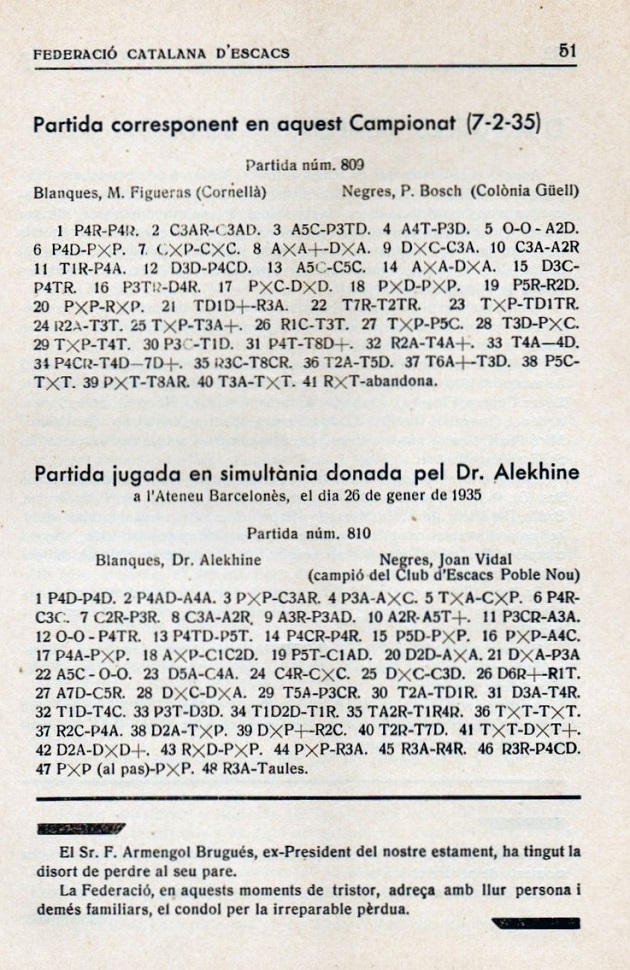
The Alekhine game against Joan Vidal played in
Barcelona on 26 January 1935:
1 d4 d5 2 c4 Bf5 3 cxd5 Nf6 4 f3 Bxb1 5 Rxb1 Nxd5 6
e4 Nb6 7 Ne2 e6 8 Nc3 Be7 9 Be3 c6 10 Be2 Bh4+ 11 g3
Bf6 12 O-O h5 13 a4 h4 14 g4 e5 15 d5 cxd5 16 exd5
Bg5
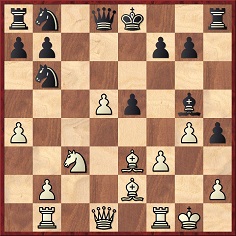
17 f4 exf4 18 Bxf4 N8d7 19 a5 Nc8 20 Qd2 Bxf4 21
Qxf4 f6 22 Bb5 O-O 23 Qf5 Nc5 24 Ne4 Nxe4 25 Qxe4
Nd6 26 Qe6+ Kh8 27 Bd7 Ne4 28 Qxe4 Qxd7 29 Rf5 g6 30
Rf2 Rae8 31 Qf3 Re5 32 Rd1 Rg5 33 h3 Qd6 34 Rdd2 Re8
35 Rfe2 Ree5 36 Rxe5 Rxe5 37 Kg2 f5 38 Qf2 Rxd5 39
Qxh4+ Kg7 40 Re2 Rd2 41 Rxd2 Qxd2+ 42 Qf2 Qxf2+ 43
Kxf2 fxg4 44 hxg4 Kf6 45 Kf3 Ke5 46 Ke3 b5 47 axb6
axb6 48 Kf3 Drawn.
Our correspondent adds the report on the event on
page 1782 of Els Escacs a Catalunya, February
1935:
‘Aquesta vegada ha efectuat dues session: la
primera tingué lloc el dia 26 a dos quarts
d’onze de la nit en l’Ateneu Barcelonès, on es
congregà una veritable multitud freturosa de
seguir les incidències de la sessió. Varen
ésser-li oposat a 43 jugadors de diverses
categories i a dos quarts de sis de la matinada,
després de set hores consecutives de joc, acabà
la sessió amb el resultat de 33 partides
guanyades, quatre empatades i sis de perdudes (+
33 =4 –6). Els vencedors foren: Claret
(Manresa), Dr. Julià (R. López), Vivet (Caixa de
Pensions), Sererols (Comtal), Morera i Mansoso
(Terrassa). Els qui empataren foren : Vidal (P.
Nou), Mestres (Terrassa), Abrahams (Barcelona) i
Serra Vinyes (Badalona).’
12116.
Staunton world champion
From page 3 of the Newcastle Daily Chronicle,
27 July 1874:
Chess is not mentioned until the latter part of the
report, but the statement that Staunton ‘has
consequently been recognised as the champion chess
player of the world’ is noteworthy and is being
added to Early
Uses
of ‘World Chess Champion’.
12117.
Staunton and friendship
From page 7 of the Newcastle Courant, 15
December 1876 (chess columnist: William Mitcheson):
The marked text reads:
‘The late Mr Howard Staunton had the gift of
making serviceable friends in a very brief
acquaintance, and he had also the unenviable gift
of throwing them off when they had served his
purpose.’
Does that claim hold up under scrutiny?
12118.
‘Abraham v Janine’ (C.N. 12106)
Christian Sánchez (Rosario, Argentina) submits the
full game, from pages 50-51 of Hohe Schule der
Schachtaktik by Kurt Richter (Berlin, 1956):

Courtesy of the Cleveland Public Library, below are
both pages from original 1952 edition of Richter’s
book:
Wanted: earlier appearances of the game, and
details of the occasion.
12119.
Alekhine in Who’s Who (C.N.s 741 &
9316)
Christian Sánchez writes:
‘Successive editions of Who’s Who
present the evolving, succinct autobiography of
their subjects. Through Alekhine’s entries, we
can trace the timeline of significant events in
his life: when he became a grandmaster,
considered himself a challenger, claimed to have
earned his doctorate in law, married, moved home
and, even, took up bridge.
Below, firstly, is his entry on page
29 of Who’s Who 1926 (London,
1926):
“ALEKHINE, (Aljechin) Alexander, chess master,
writer, and at present, student of Paris
University, for Law Doctorate; b. Moscow, 1 Nov.
1892; s. of A. Alekhine, Maréchal de Noblesse of
Voronej’s Government Nobility, and Member of the
Douma, and A. Prokoroff, d. of the Moscow
Industrial Magnate. Educ.: the Imperial High Law
School for Noblemen, the Pravovedenie,
Petrograd. After taking his law degree in 1914,
entered the Foreign Office; his career was
interrupted by the Revolution, when he emigrated
to France; served voluntarily in the Great War
as Red Cross representative at the front (Sign
of the Red Cross, the Military Cross of St
Stanislas, and the St George’s Cross); as chess
player he got the title of Master at the age of
sixteen, 1909, and the title of Great Master in
1914; has to his credit more than twenty
international Tournaments, and holds the world’s
record for Blindfold Chess (New York 1924, and
Paris 1925); challenger of Capablanca for the
World’s Championship in chess. Publications:
Chess in Soviet Russia, 1921; New York
Tournament Book, 1924; Hastings Tournament Book,
1922; publications in French and foreign
periodicals; My Best Hundred Games. Recreations:
riding, canoeing, tennis. Address: 211 rue de la
Croix-Nivert, Paris XV.”
Changes or additions in subsequent editions:
1927: –;
1928: “Doctor of Law of Paris University; m.
Nadejda Fabritsky, widow of General V.
Vassilieff; [My Best Hundred Games], 1908-1923;
N.Y. Tournament Book, 1927.”
1929: “Chess Champion of the World since 1927;
My Best Games of Chess, 1927.”
1930: –;
1931: “Defended his title successfully 1929;
Produced a World’s record score in San Remo
Tournament, 1930; bridge.”
1932: –; 1933: –
1934:“on visiting Iceland, made Knight of the
Order of Falcon; On the Way to the World
Championship, 1932; ping pong.”
1935: “m. Grace Wishaar, widow of Captain
Archibald Freeman; [Blindfold Chess] Chicago
1933; [Defended his title successfully 1929]
and 1934; Le Château, St. Aubin-le-Cauf, Seine
Inférieure, France.”
1936: –
1937: “[Chess Champion of the World],
1927-35; on visiting French Africa was made
Commandeur of the Nichum Iftikar (sic:
Nichan Iftikhar) and Knight of the Ouissan
Alaouit (sic: Ouissam Alaouite); Zürich
Tournament Book, 1934.”
1938: “Nottingham Tournament Book, 1936; Deux
Cents Parties d’Échecs, 1937.”
1939: “Chess Champion of the World; won the
world’s Title from J.R. Capablanca in 1927;
defended it successfully in 1928 [sic]
and 1934; lost it against Dr Euwe in 1935 and
regained it from him in 1937; London
Tournament Book, 1932.”
1940: –; 1941: –; 1942: –; 1943: –; 1944: –;
1945:–
1946: Obituary: 24 March 1946. Shown in
C.N. 9316.’
12120.
Marshall by John Hix
The ‘Strange as it seems’ feature by John Hix on
page 15 of the Omaha World-Herald, 21 April
1931:
12121.
Skittles games between Capablanca and Kostić
From Ben R. Foster’s chess column on page b7 of the
St Louis Globe-Democrat, 18 July 1915:
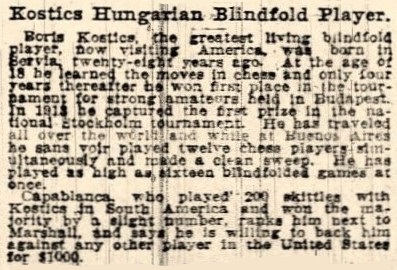
Statements by and about Kostić require particular
care. What is known about the ‘200 skittles’ claim?
12122.
Capablanca and Kostić in Buenos Aires
Olimpiu G. Urcan (Singapore) provides this
photograph from an unnumbered page of Fray Mocho,
28 August 1914:
Larger
version
A red dot marks Kostić.
Can a better copy of the photograph be found?
12123.
Newspapers online
Viewing old newspapers online inevitably brings
occasional disappointments as a result of
illegibility:

Liverpool Post
& Mercury, 7 April 1923, page 4.
12124.
Newspapers online
Viewing old newspapers online inevitably brings
occasional disappointments as a result of
legibility:
Illustrated
Police News, 9 January 1897, page 7
Evening Express,
18 July 1922, page 4
Liverpool Echo,
22 September 1942, page 4
12125. A
knight on K6
From Christian Sánchez (Rosario, Argentina):
‘Your feature article A
Knight on K5, K6 or Q6 gives the earliest
date for the quote as 1929. In the notes to the
move 15...QR-Q1 in the Lasker-Capablanca game
(St Petersburg, 1914, round 18), page 66 of The
Grand International Masters’ Chess Tournament at
St Petersburg, 1914 (Philadelphia, [1914])
quotes Louis van Vliet in the Sunday Times:
“Why allow Kt-K6, while it could be prevented
by B-B1? The great Anderssen used to say: ‘Once
get a Kt firmly posted at K6 and you may go to
sleep. Your game will then play itself!’ (V.)”.’
See note (e) below in the full column published on
page 17 of the 31 May 1914 edition of the Sunday
Times:
12126.
Abraham v Janny (C.N.s 12106 & 12118)
Peter Anderberg (Harmstorf, Germany) provides page
315 of Schachjahrbuch 1923 by Ludwig
Bachmann (Ansbach, 1924):
No occasion is mentioned for the Abraham v Janny
game, but there are now the players’ initials.
12127.
Another Staunton obituary
Further to C.N. 12116, below is the obituary of
Howard Staunton on page 4 of The Scotsman,
29 June 1874:
Beyond such curiosities as ‘a native, we believe,
of Warwickshire’, ‘educated at Eton and Oxford’ and
‘the conqueror of Murphy’, the text illustrates how
mainstream obituaries of Staunton might focus on
Shakespeare and not chess. The English-language Wikipedia article
on Staunton does the reverse.
Possible reasons for the decline in Staunton’s
standing as a Shakespeare authority were given by,
in particular, Richard Allen in C.N. 5603. See Howard
Staunton and William
Shakespeare
and Chess.
Attacks
on
Howard Staunton includes chess observations
by, among others, Fred Reinfeld, Al Horowitz and
Larry Evans. Remarks by Evans are discussed in
detail in The
Facts about Larry Evans, and here is another
one:
Reno
Gazette-Journal, 18 April 1987, page 33
12128.
The Menchik sisters
No information is available on whether any chess
outlet has ever paid money to getty
pictures for a large, clean copy of the above
photograph. Nor do we know why it is believed to
show Vera Menchik, as opposed to her sister Olga.
Complementing the images of the sisters in The
Vera Menchik Club, below is a photograph from
page 14 of the (London) Daily Chronicle, 13
January 1926:
12129.
Levitzky v Marshall, Breslau, 1912
Wanted: more detailed local (i.e. Breslau/Wrocław)
information about Marshall’s
‘Gold
Coins’
Game, and also about the loser.
Other games where a queen moves to KKt6 (i.e. g6 or
g3) are discussed in The
Fox
Enigma.
Frank James Marshall
by Frederick Orrett (see C.N. 9722)
Regarding the alleged gold coins episode, the
English-language Wikipedia
page
on
the game currently cites, of all things, a
2006 book published by Cardoza:
‘Eric Schiller wrote, “others say they were just
paying off their wagers”.’
C.N. 12063 referred to the existence of a Wikipedia
project group created to ‘improve information on
chess-related articles’. The project group states:
‘Print sources are generally considered reliable,
but certain authors such as Eric Schiller and
Raymond Keene have a reputation for
unreliability.’
12130.
Edgar Pennell and the skewer
Recent C.N. items referring to Wikipedia are a
reminder that its entry on the chess
term
skewer does not currently name the man who
coined it, Edgar
Pennell.
The photograph on page 275 of CHESS, 14
April 1937 (C.N. 8894) had already appeared widely
in the press, in the United Kingdom and the United
States. From page 6 of the Liverpool Daily Post,
16 June 1936:
The originator (probably by 1937) of the chess word
‘skewer’ was shown in the Liverpool Daily Post,
30 January 1939, page 6:
Pennell’s name was seldom seen in chess literature,
although page 153 of the May 1955 BCM
reported that in Cheltenham on 19 March, during the
National Chess Week, he had participated in a Chess
Brains Trust, alongside C.H.O’D. Alexander, J.M.
Aitken and J. Bronowski. The subjects included ‘Is
chess a waste of time?’ and ‘Why are lady
chessplayers outclassed by men, even in Russia?’.
From John Townsend (Wokingham, England):
‘An article in the Staffordshire Sentinel
(31 January 1939, page 6) referred to Edgar
Pennell as “a native of Bucknall”. This is
Bucknall, Staffordshire, near Stoke-on-Trent.
Since the birth of an Edgar Pennell was
registered in the district of Stoke-on-Trent in
the third quarter of 1902 (G.R.O., birth
indexes, volume 6b, page 192), and the death of
an Edgar Pennell was registered in 1985 in the
district of Windsor and Maidenhead (death
indexes, volume 19, page 68) which included the
date of birth of 21 June 1902, there is no doubt
that this is the skewer man.
Edgar Pennell’s birth certificate shows that
he was born on 21 June 1902 at Eaves Lane,
Bucknall; his parents were Ernest Pennell, a
schoolmaster, and Bessie Ethel Pennell (formerly
Mann). The birth was registered on 21 July 1902.
His marriage to Leah Bailey was registered
during the first quarter of 1927 in the district
of Liverpool (source: G.R.O. marriage indexes,
volume 8b, page 234).
Edgar Pennell’s death was registered on 3 June
1985 in the district of Windsor and Maidenhead
(volume 19, page 68). His death certificate
shows that he died on 2 June 1985 at Upper
Orchard, Mill Lane, Cookham, Berkshire. His date
and place of birth were given as 21 June 1902
and Bucknell [sic], Staffordshire. He
was a retired school teacher. The informant was
named as Alwin Gilbert Allen, whose
qualification was “Causing the body to be
cremated”, and his usual address was The
Bungalow, Odney Common, Cookham, Berkshire.
The cause of death was entered as:
“Myocardial Infarction
Coronary Atheroma
Certified by Julia Mercer MBBS.”
His wife was a couple of years younger and
died on 24 November 1992 at Sandpipers
Residential Home, Worster Road, Cookham,
Berkshire. Her will was proved at Winchester on
29 December 1992, the estate not exceeding
£125,000.’
12131.
Rubinstein photograph
We are authorized to show this portrait of Akiba
Rubinstein which is held by the Jewish
Museum
of Belgium:
12132.
Max Ritter von Gomperz
Michael Lorenz (Vienna) has provided an extract
from ‘a balance sheet in the probate file of the
Austrian banker, industrialist and chess patron
Max von Gomperz (1822–1913) which shows that every
month he paid 174 Kronen in support of
chessplayers’:
Larger
version
Our correspondent draws attention to the obituary
and photograph of von Gomperz on pages
290-293 of the October-November 1913 Wiener
Schachzeitung.
12133.
The Mouthless Dead
The latest book featuring the Wallace
murder
case is an elegant novel by Anthony Quinn, The
Mouthless Dead:
The phrase ‘the mouthless dead’ is from the first
line of a posthumously published poem
by Charles Hamilton Sorley (1895-1915).
12134.
Prison warders
In the United Kingdom a number of individuals
convicted of capital offences played chess against
prison warders. The following appeared under W.H.
Wallace’s name on pages 8-9 of John Bull, 14
May 1932:
‘I see clearly in the freedom of my bedroom the
faces of the warders of the death-watch at the
condemned cell – the faces that will never leave
me, day or night, until the end comes.
I see myself again playing chess with them. ...
I wonder – do they still play chess? I taught
them.’
Wallace described on page 19 of John Bull,
30 April 1932 how he was publicly perceived:
‘I was not only “the man Wallace” but “another
Rouse”.
He was referring to Alfred Arthur Rouse
(1894-1931), the ‘blazing car murderer’. A report
about Rouse on page 1 of the (London) Evening
Standard, 7 March 1931 stated:
‘In the condemned cell he is guarded day and
night by two warders. During the daytime he has
exercised in the small prison yard and in the cell
he plays draughts and chess with the “death
guard”.’
From the front page of the (Sunday) People,
8 March 1931:
Page 6 of the Evening Express (Liverpool),
7 March 1931 described Rouse as ‘an expert chess and
draughts player’. Journalists often misapply
‘expert’ and ‘champion’ to prisoners and prodigies.
Another case was John George Haigh (1909-49), the
‘acid bath murderer’. From page 3 of the Daily
Herald, 21 July 1949:
Chess
and
Murder mentions Neville George Clevely Heath
(1917-46), who ‘played a certain amount of chess
with the warders, two of whom were in his cell day
and night’. Concerning William Joyce (1906-46), C.N.
11446 related that, before being hanged for high
treason, ‘in the condemned cell he has played chess
with the prisoner officers’.
From page 1 of the Evening Despatch
(Birmingham), 31 August 1948:
The article was on pages 314-315 of the September
1948 BCM:
Acknowledgement for
the BCM scan: Cleveland Public Library
12135.
Close and closed
Whether referring to openings, games or positions,
the terms ‘close’ and ‘closed’ tend to be vague and
interchangeable. With openings, for instance, they
have traditionally been applied when 1 e4 did not
occur – in contrast to 1 e4 e5 (open games) and 1 e4
answered by a move other than 1...e5 (semi-open
games). However, would many writers nowadays
specifically classify 1 d4 f5 2 e4, for example, as
a ‘close’/‘closed’ game? To what end?
When a position is to at least some extent
blocked, ‘closed’ may seem more logical than
‘close’, with the bonus of avoiding ambiguity, since
‘it was a close game’ normally suggests a narrow
victory.
Where is the best guide to such terminology, and
are there languages with concepts or nuances unknown
in English?
12136.
Lasker on Maróczy
From Emanuel Lasker’s column in the New York Evening
Post, 2 May 1908, page 9:
‘Maróczy has the emotional nature of the Magyar,
and is therefore as variable as his moods. He can
play all styles, the highest and the lowest, and
neither his upper nor his lower limits have yet
been determined. Hence he is somewhat of a riddle,
that could be solved only if he pitted himself
against the foremost masters in match play, but he
resolutely declines to do so. Perhaps he likes to
remain a mystery.’
12137.
Abrahams v Maróczy
A good copy of this photograph would be welcome:
Evening Express
(Liverpool), 6 January 1930, page 5
12138.
Gerald Abrahams
The shot of Gerald Abrahams in C.N. 12137 is a
reminder of an unresolved matter in C.N. 10985:
given that Abrahams was born in 1907, how can the
National Portrait Gallery, London put ‘1933’?
12139.
Abrahams on Yates
On page 6 of the Liverpool Post & Mercury,
14 November 1932 Gerald Abrahams paid tribute to F.D. Yates:
From page 6 of the following day’s newspaper:
Yates’s loss to Sir George Thomas in Canterbury
(1930) has been widely published. For a group
photograph of participants in the tournament, see
C.N. 4350.
12140.
Staunton’s early life
C.N.s 12116 and 12127 prompt an addition to Predicaments
for
Chess Writers: the task of writing just a
factual line or two about Howard Staunton’s early
(pre-chess) years.
12141.
Staunton and friendship (C.N. 12117)
From John Townsend (Wokingham, England):
‘In C.N. 12117, the chess columnist William
Mitcheson stated that Howard Staunton “threw
off” friendships when they were no longer of
service to him. No evidence for his assertion
was offered, and no examples were provided.
It cannot be doubted that Staunton made
enemies, but the same could be said of other top
players who have been world champion or regarded
as the world’s best, or who have achieved great
fame. The examples of Steinitz and Alekhine
spring to mind, while Lasker and Capablanca
acquired reputations for making challenges
difficult to mount, resulting in tensions. Is
there not something special about the position
of a champion which provokes envy, rivalry and
hostility? They are there to be shot at.
In the case of Staunton, he was, in addition,
a forthright man. The art critic Thomas
Jefferson Bryan, in comparing him with
Saint-Amant, preferred Staunton’s openness and
made the following observation:
“Mr Staunton cares not to appear other than he
is. I make no pretensions to etiquette, but
common sense induces me to prefer his sincerity
– and I confess his mode of behaviour is the
more pleasing to me – for we cannot accuse him
of carrying his politeness to an undue excess.”
(Source: Chess Player’s Chronicle,
1846, page 147.)
In a letter to the City of London Chess
Magazine (January 1875, pages 12-13), von der
Lasa referred to Staunton’s own remarks about
his associations with five notable chess
figures:
“Staunton’s letter of November last [1873]
was altogether written in a most friendly tone,
and spoke likewise in affectionate terms of
other players. ‘I was sorry’, he wrote, ‘to lose
Lewis and St Amant, my dear friends Bolton and
Sir F. Madden, and others of whom we have been
deprived, but for Jaenisch I entertained a
particular affection, and his loss was
proportionately painful to me. He was truly an
amiable and an upright man.’”
In the case of the problemist Reverend
Horatio Bolton, a Norfolk clergyman, he
had been a friend since at least 1840, when the
two contested a correspondence match, and he was
referred to as a friend in a letter as late as
1873, the year of Bolton’s death.
Von der Lasa acknowledged that Staunton was
responsible for “animosities” in the world of
chess and attributed the cause to “his great
irritability of temper”, which resulted from his
heart problem.
In the world of Shakespearean studies,
Staunton enjoyed a long and rewarding friendship
with the scholar James Orchard
Halliwell-Phillipps. Their correspondence (see
C.N. 11993) ended only with Staunton’s death in
1874, having begun in 1855 or earlier. Their
exchanges are respectful and nearly always
cordial. These qualities are not diminished by
the odd blunt remark made by Staunton; neither
is their friendship jeopardized by it.
Finally, it is relevant to mention here his
wife Frances, to whom he was married for 25
years. The impression left is that their
marriage was harmonious, since no evidence is
known that during that time the two of them even
quarrelled, let alone had a serious rift.’
12142.
S.S. Boden’s father (C.N. 12094)
Also from John Townsend:
‘C.N. 12094 discussed inter alia the
disappearance of S.S. Boden’s father, James
Boden, who, after a career as a nonconformist
minister, died at Hoxton, Middlesex, in December
1851, and it was suggested that his family were
not proud of him when he died. The possibility
was mentioned, speculatively, that he may have
spent some time in the lunatic asylum at Hoxton.
In census returns, it was common practice in
certain institutions, including prisons and
hospitals, to refer to inmates or patients by
their initials only. An example of that is the
nineteenth-century chessplayer John Brand
(“JB”), a lunatic in the 1851 census. (For
details, see page 75 of my book Historical
notes on some chess players.)
On that analogy, an entry for “Warburton’s
Licensed Madhouse” in the 1851 census at West
Hackney is of interest (National Archives, HO
107/1504, page 544). This institution comes
immediately after the entry for 10 De Beauvoir
Crescent. Living at the madhouse was a man who
was referred to in the census as “JB”, described
as a patient, unmarried, aged 55, a clergyman,
whose place of birth was not known. James
Boden’s occupation matches well with that of
“JB”, even though the age appears to be wrong by
five years. Edward P. Beverley MRCS, aged 23,
unmarried, was “resident surgeon” at the
madhouse.
So the question is: was James Boden, father of
S.S. Boden, the man referred to as “JB”, and was
he a patient at Warburton’s Licensed Madhouse?
That would account for his detachment from the
rest of his family.
Can any light be thrown on this?’
12143.
Anatoly Karpov
A 1970s portrait (courtesy of the State Russian
Museum and Exhibition Centre Rosphoto):
12144. The
Quaade Gambit
Position after 1 e4
e5 2 f4 exf4 3 Nf3 g5 4 Nc3
Further to C.N.s 8587 and 8589 (see A
Chess Gamelet), Jens Askgaard (Køge, Denmark)
writes:
‘An article about Louis Quaade was published
on pages 49-51 of the Danish magazine Skakbladet
2016/1.
The author, Michael Agermose Jensen, found an
entry for Quaade in the Danish census for 1880.
Quaade is listed under his full name, Louis
Magnus Johan Christian Carl Quaade, born in 1825
and unmarried, as “Patient no. 913” at Oringe.
Here, “Oringe” refers to Oringe Psychiatric
Hospital. Oringe is a small peninsula, where the
hospital was built, and Vordingborg is the
adjacent town.
Jensen also speculates that Quaade was assumed
to be Dutch owing to the confusion of names Oringe
=> Orinje => Oranje. He mentions the
Danish chessplayer Orla Hermann Krause, who was
employed as a doctor at Oringe from 1901, and
wonders whether he ever met Quaade.
I have found a family history, Den
Danske Quade-Quaade-Qvadeslægt, published
by Carl Anton Frederik Qvade in 1928. In the
book the parents of Louis Quaade are given, on
pages 86-89, as Peter Friedrich Quaade
(1779-1850) and Christiane Gustava Quaade, née
de Tuxen (1792-1866), which differs from the
information at Geni.com.
There, Louis Quaade’s father is named as Georg
Joachim Groothschilling Quaade, who was his
brother according to the family history.
The bibliography of Louis Quaade can be found
on pages 95-96. He was born in Helsingør
[Elsinore] on 17 March 1825 and was accepted at
Landkadetakademiet [today, known in English
as the Royal Danish Military Academy] in 1840.
He was promoted to Second Lieutenant in
1846 and to Premier Lieutenant [First
Lieutenant] in 1849, and he fought in the First
Schleswig War, 1848-50. Permission to leave the
army in 1860 owing to frailty was granted, and
he was simultaneously promoted to Kaptajn
[Captain]. He died in Oringe on 13 September
1906.
If Quaade was an army captain, why would the Oxford
Companion
to Chess refer to him as a sea captain? I
believe that this is another translation error.
In the German army, the rank Kapitän is
not used – the corresponding rank is Hauptmann.
A German Kapitän would indeed refer to a
sea captain.’
12145.
Orange
The previous item reminds us of some cutting-edge
reportage about Gerald Abrahams on page 5 of the Liverpool
Echo, 24 August 1950:
12146.
The London Rules
In the column on page 3 of the Manchester
Guardian, 14 August 1922 by ‘a chess
correspondent’ the London
Rules were not welcomed:
When the text was published the same day on page 11
of the Liverpool Post & Mercury, the
heading stated ‘By J. Gunsberg’.
12147.
Walter de Havilland
From Stephen Wright (Vancouver, Canada):
‘Your feature article on Alekhine
v
Kimura mentions the English player Mr
Havilland. I do not think that it has been
widely realized that this was Walter de
Havilland, the father of the film stars Olivia
de Havilland and Joan Fontaine. In later life
his home was in British Columbia.’
On his British Columbia Chess History website our
correspondent has written an
article about Walter Augustus de Havilland
(1872-1968).
12148.
W.H. Wallace’s chess books
Quoting from page 234 of Checkmate The Wallace
Murder Mystery by Mark Russell (London, 2021),
our feature article Chess
and the Wallace Murder Case notes that in May
1931 W.H. Wallace, awaiting his appeal against
execution, requested a list of books – chess being
one of the subjects.
Wallace’s conviction was quashed by the Court of
Criminal Appeal on 19 May 1931, and we are grateful
to Rod Stringer (Liverpool, England) for providing
documentation from later that month:
Larger
version
Larger
version
Larger
version
Chess Sacrifices and Traps was by Alfred Emery.
The other book (Modern Chess Strategy,
published anonymously by the Daily Express)
was discussed in C.N. 1743. See Chess
Jottings. Publication was announced on page 5
of the Daily Express, 17 January 1931, i.e.
three days before Julia Wallace was killed:
12149.
Staunton’s early life (C.N. 12140)
John Townsend (Wokingham, England) writes:
‘In C.N. 1453 (the July-August 1987 issue of
your magazine), the late W.D. Rubinstein raised
some pertinent questions regarding the origins
of Howard Staunton and his early life. In what
follows, these questions are considered again
today in the light of discoveries made during
the intervening period.
“Is anything more now known about the ancestry
of Howard Staunton than when Keene and Coles’
biography appeared in 1975? According to the
account in the Oxford Companion to Chess,
‘nothing is known for certain about Staunton’s
life before 1836’.”
Nothing more is known for certain, but
important clues have come to light in three
areas:
1. Staunton has been found on the 1861 and
1871 censuses; in both cases, his place of birth
was entered as Keswick (in the county of
Cumberland).
In the 1851 census, his birthplace had been
recorded as “Westmorland”; that is, the county
alone was named, without a village, town or
parish, which is unusual.
His age on all three censuses is fairly
consistent and suggests birth about 1810.
Westmorland is not strictly consistent with
Keswick (Cumberland), although it could be
deemed consistent if he was born in a
Westmorland parish close to Keswick, since those
supplying the census information were encouraged
to name the nearest town of consequence.
In my opinion, the information that he was
born in Keswick, or Westmorland, though possibly
correct, needs to be treated with caution, since
Staunton himself is the sole source of it. The
same applies to his father being named as
William Staunton, gentleman, on his marriage
certificate: it may, or may not, be true.
2. There is strong evidence that Howard
Staunton was referred to as Charles Staunton, or
Charles Stanton, in 1838-39, during the period
when he was secretary of the Westminster Chess
Club.
Detailed discussion of this last topic
appeared in my two books, Notes on the Life
of Howard Staunton (pages 1-15) and Historical
Notes on Some Chess Players (pages 109-135).
For readers who do not have access, in what
follows I offer a summary of those discussions.
Chess sources show that during most of 1839,
the Westminster Chess Club met at 26 Charles
Street, St James’s Square, with Howard Staunton
as its secretary. In those days, a “rates”
system was operated in England by which the
occupiers of property were required to
contribute towards various services provided by
the parish. 26 Charles Street was divided into
several apartments, one of which was occupied by
a man named “Charles Staunton” in two rates
documents, and spelt “Charles Stanton” on two
other occasions. Another source, Robson’s
Court Guide (1840 edition) names the occupier
as Howard Staunton, Esq., so there is an obvious
inference that Charles Stanton/Staunton was a
name used at that time by the famous
chessplayer.
In addition, Charles Stanton, Esq., was a
subscriber to William Greenwood Walker’s 1836
book about the McDonnell v Labourdonnais games.
As no other chessplayer by the name of Charles
Staunton, or Charles Stanton, is known at that
time, it seems likely that this is another
reference to Howard Staunton. Some commentators
have doubted this conclusion because there is
also a separate entry for “H. Staunton, Esq.”.
One needs to bear in mind the unusually high
frequency of errors in Walker’s book. His
namesake, George Walker, described it as
“disfigured by ten thousand errors of press”.
There are other instances of subscribers
appearing twice; for example, on page 280 the
members of the Bristol Chess Club are all listed
twice, the second list being slightly different.
If both entries referred to Staunton, it would
mean the name Charles Staunton, or Charles
Stanton, was used by him at least during the
period 1836-39, perhaps longer, and it may be a
clue to his origins. The evidence of the
rate-books is strong, not least because they are
an official and objective source, and the
information they contain is not dependent on
Staunton himself, as is the case with certain
other sources.
The lives of several individuals by the name
of Charles Staunton, or Charles Stanton, have
been explored and compared with known facts
about Howard Staunton; most have been discarded
as impossible or unlikely, though in one or two
cases without any certainty.
One clear candidate remains, and there is
significant evidence, but no proof, that he was
Howard Staunton.
William Charles Stanton is referred to in a
land tax document of 1830 (“W.C. Stanton”), when
he resided in Motcomb Street, near Belgrave
Square. Later he moved to Coleshill Street, and
by 1834 was at Selwood Place, Brompton. He had
two children with a woman, Mary Frailing, being
referred to in 1834 as “Charles Staunton”. The
parish register baptism entries read as if the
children were born in wedlock, but no evidence
of a marriage has been found. Mary Frailing was
buried at Brompton on 14 November 1834, referred
to as “Mary Fearling Staunton”, aged 25; the
cause of her death is not known.
William Charles Stanton continued to appear in
the rate books of Brompton for a short time,
until September 1835, after which no further
information about him is known. My theory is
that he became Howard Staunton, who is first
mentioned by that name in 1836.
The elder child, Agnes Staunton, went to
school in Fulham and was married at Paddington
in 1848 at the age of 18, her father being named
as “Charles Staunton”. She had several children
and died in Naples in 1888.
The other child, Charles Staunton, was brought
up at Putney by Jemima Freeling, his aunt. He
became an assistant schoolmaster, then a
journalist, and later worked for a building
society. His literary and historical pursuits
resembled those of Staunton, and he submitted
several questions to the periodical Notes
and Queries. He was a sub-editor of the
Oxford English Dictionary. He had an outgoing
personality and gave addresses on a variety of
subjects. In 1859, he offered himself as a Tory
candidate for a parliamentary election in
Brighton, in the event that no other candidate
could be found. Recently, much more information
has come to light about this Charles Staunton’s
final years, in Somerset. He died in Taunton in
1867.
A clear link between William Charles Stanton
(sometimes referred to as Charles Staunton) and
Howard Staunton remains to be established.
3. Since the time of Professor Rubinstein’s
query, more has been learned about Staunton’s
life between 1845 and 1849. This has included
details of addresses where he lived. During 1847
and 1848, he resided at 6½ Park Place, Fulham
Road (Chelsea), his landlord being Thomas
Tombleson, a builder and a Battle of Trafalgar
veteran, who paid the rates there.
I acknowledge gratefully the valued assistance
of Liverpool Chess Club, which kindly gave me
access to images of certain Staunton letters in
their archives.
These included two 1846 letters addressed from
6 Park Place, Fulham Road (Chelsea); it is
assumed that 6 was the number before the
property was divided into two separate
addresses, so, effectively, Staunton’s residence
in Park Place has been extended backwards by
about one year.
More important is an entirely new address, 15
Brompton Row, Fulham Road, which appears on two
1845 letters owned by the Liverpool Chess Club.
This address was in the parish of Brompton,
being very close to Knightsbridge. It is his
earliest known residence in Brompton. Searches
in rate-books and London directories strongly
suggest that it was a lodging house at that
time. Brompton Row is an interesting street
because it was much favoured by actors, an
occupation thought to have been pursued by
Staunton. Still, there is no proof that Staunton
was an actor, despite this and other evidence.
“Have the Westmorland parish registers for the
spring of 1810 ever been searched for a record
of his birth?”
Births were not routinely recorded in parish
registers, although the baptism registers do
sometimes include the date of birth.
I am not aware of any factual basis which
supports Staunton’s having been born
specifically in the spring of 1810. Since the
1861 and 1871 censuses both give Keswick as his
place of birth, parish registers for the county
of Cumberland need to be considered too.
In C.N. 1471, Ken Whyld noted that he and
David Hooper had examined the Westmorland parish
registers for every male child born of a father
named William in the period March-September
1810.
This search was limited to the county of
Westmorland. I am not aware that Whyld published
details of this work, hence the sources used are
not known. I suspect that the International
Genealogical Index was used, in which baptism
records are indexed.
In that part of the country at that time, it
was common for baptisms to take place many
months and sometimes even two or three years
after birth. This can be seen clearly in the
baptisms of Crosthwaite (which included the town
of Keswick). It is insufficient to consider only
baptisms during the year 1810; a more realistic
approach would be one which covered baptisms
between 1810 and 1813, and even then it may be a
mistake to assume that Staunton was born in
1810.
The variant Stainton is common in both
Cumberland and Westmorland, where Staunton and
Stanton are uncommon. I myself have used the
International Genealogical Index as a finding
aid to studying Staunton, Stanton and Stainton
baptisms in the counties of Cumberland and
Westmorland, but not in any systematic way. I
did not find any Staunton, Stanton or Stainton
baptisms that struck me as likely candidates to
be Howard Staunton, having paid closer attention
to those parishes in the vicinity of Keswick. It
cannot be ruled out that his baptism was under a
name which is not recognizable as his.
It is worth noting in passing that transcripts
of the parish registers of Crosthwaite, which
included Keswick, were printed as far as the
year 1812: Henry Brierley and Francis Haswell, The
Registers of Crosthwaite, 1562-1812, four
volumes, Penrith, 1928-31. These include full
details of several illegitimate baptisms during
1810 and 1811 which I have tried, without
success, to link with Staunton.
“If he was not the illegitimate son of the
fifth Earl of Carlisle, how did the rumour arise
that he was, given that the Earls of Carlisle
were not really household names among the
English aristocracy?”
That seems a fair point, although it does not
constitute evidence that the fifth Earl of
Carlisle was the father. According to Tim
Harding in Eminent Victorian Chess Players
(page 35), the rumour that Staunton was a
natural son of the fifth Earl of Carlisle was
first printed in Frederic Boase’s Modern
English Biography in 1901. Actually, in Boase
it is more a statement of fact, as the word
“rumour” is not used: “natural son of 5 earl of
Carlisle (1748-1825)”. It is not known where the
information came from.
“The fifth Earl (1748-1825) would have been 62
when Staunton was born. According to the Dictionary
of National Biography he was a playwright
of some note and was Chancery guardian to Lord
Byron, which might be of relevance, given
Staunton’s literary pursuits. There is no
mention of Howard Staunton in his will. Could
Staunton possibly have been the illegitimate son
not of the fifth Earl, but of one of his sons –
for instance of his third son Lord Frederick
Howard, who was born in 1785 and was killed at
Waterloo? Has any research been done with their
wills?”
It is not easy to disprove this. However, the
will of (Major) Frederick Howard (National
Archives, PROB 11/1578/439) is quite short and
mentions no children or anyone who could be
interpreted as Howard Staunton.
If one were to fancy a son of the fifth Earl
of Carlisle to be Staunton’s father, a better
choice would be the sixth Earl, George Howard
(1773-1848). He was a prolific begetter of
(legitimate) offspring during the periods both
before and after 1810, though it is not known
whether he also had any illegitimate children.
In those days, his title was Viscount Morpeth,
as he did not become Earl until 1825. He had
close associations with Cumberland, having been
MP for the county for a number of years. His
will was also very short: he left everything to
his son (National Archives, PROB 11/2106/138).
There is no evidence that the fifth Earl or
either of his two sons mentioned above was
Staunton’s father.’
12150.
Enrique Sánchez of Walthamstow (C.N. 8683)
C.N. 8683 gave the following, from page 166 of CHESS,
April 1940:
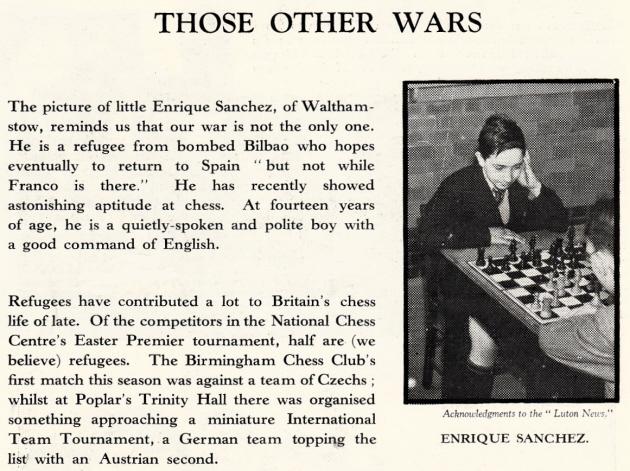
No further information about Enrique Sánchez was
available, but now John Saunders
(Kingston-upon-Thames, England) writes:
‘It would appear that Enrique Sánchez died in
Walthamstow in April 1943, aged 17. I provide a
number of images by way of corroboration:
(1) Death register record, showing the date
and location of the registered death:
(2) Image taken from the Queens Road Cemetery
(Walthamstow) Register. This shows that Enrique
Sánchez, aged 17, was buried in the cemetery on
29 April 1943, with the purchaser of the plot
being Percy Friedberg, of 238 Queens Road,
Walthamstow, E17, who himself was buried in the
same plot a year later, followed by Percy’s
widow Beatrice in 1953:
Larger version
(3) A further image from the cemetery register
indicates that Enrique Sánchez died at 238
Queens Road, which shows that he was lodging
with Mr and Mrs Friedberg at the time of his
death:
Larger version
Although I cannot prove definitively that the
chessplaying Enrique Sánchez and the person who
died in 1943 were one and the same, the
circumstantial evidence seems overwhelming.
Further research into Percy and Beatrice
Friedberg shows that they were very active in
socialist politics in London and took an
interest in Spanish politics, so it is highly
likely that they would have been ready to house
a young refugee from the Spanish Civil War. That
said, their September 1939 census record
confirms that Enrique Sánchez was not staying
with them at that time.
I did wonder whether the 1943 death might have
been the result of enemy action but could find
no references to this. Also, the house where he
died continued to be occupied after Sánchez’s
death, so it seems improbable.
I could find no specific newspaper references
to Enrique Sánchez apart from two columns
written by T.W. Sweby, in 1988 and 1992. We
learn that the young man’s full name was Enrique
Sánchez Villardo and that he had a sister, born
circa 1930, who was also a refugee. A
search for details about her has proved
unsuccessful. Sweby makes no mention of
Sánchez’s early death, so either he was unaware
or else my whole thesis is incorrect.’
 Luton News,
30 December 1988, page 21
Dunstable Gazette,
14 October 1992, page 29.
John Saunders is the founder and archivist of BritBase.info.
12151.
Moscow, 1994
Tony Bronzin (Newark, DE, USA) writes regarding Garry
Kasparov
on Modern Chess Part Four: Kasparov vs Karpov
1988-2009 (London, 2010):
‘I wanted to read Kasparov’s version of the
behind-the-scenes happenings of the 1994 Moscow
Olympiad, delineated so well in Inside
Chess and barely touched upon in Chess
Life. Since Kasparov devoted multiple pages to
why the 1983 Pasadena match with Korchnoi did
not take place and 30 pages to his version of
what happened after game 48 of the first match
with Karpov, situations where at least a case
can be made that he was wronged, surely Kasparov
would have at least said something about the
1994 Olympiad and why Karpov was not allowed to
field a second Russian team. Not a peep ...’
We are grateful to Yasser Seirawan (St Louis, MO,
USA) for permission to show the coverage (nine
pages) in the 1/1995 issue of Inside Chess.
12152.
Levitzky v Marshall, Breslau, 1912
A number of webpages (the above
is one example) have a photograph of Levitzky in
play against Marshall, with or without a claim that
it was taken during the ‘Gold
Coins’
Game. What is known about the provenance of
the picture?
12153.
Would
Concerning recourse to ‘would’ in historical
narratives, an addition to Chess
and
the English Language comes from page 178 of The
Killing
of Julia Wallace by John Gannon (Stroud,
2012):
12154.
Testing annotations
From the front cover of the October 1966 issue of CHESS:
The unnamed author was P.H. Clarke.
Concerning the observation by C.H.O’D. Alexander –
‘It passes one of the best tests of a well-annotated
book: the winner’s moves are quite frequently
criticised’ – that full review is sought. The words
were not in the chess column on page 39 of the Sunday
Times
Magazine, 7 May 1961, where Alexander compared
the Clarke book favourably to Selected Games of
Mikhail Tal by J. Hajtun (London, 1961).
See too Chess
Annotations.
12155.
Chess by wireless
Eduardo Bauzá Mercére (New York, NY, USA) has sent
us the following, from page 7 of the Minneapolis
Journal, 18 June 1902:
We note that the game was published on, for
instance, page 6 of the Weekly Irish Times,
21 February 1903:
1 e4 e5 2 Nc3 Bc5 3 Nh3 d6 4 Qf3 h6 5 Bc4 Nf6 6 d3
Bg4 7 Qg3 O-O 8 Nd5 Bxh3 9 Qxh3 Nxd5 10 Bxd5 c6 11
Bb3 Nd7 12 O-O Qf6 13 Qxd7 Resigns.
A report about the game from page 9 of the Champaign
County Gazette, 21 January 1903 [sic –
the page was misdated 21 January 1902]:
See also Chess
and
Radio.
12156.
Capablanca’s praise for Lasker
Page 273 of our monograph on Capablanca gave his
words about Emanuel Lasker on page 12 of the New
York Times, 11 January 1936:
‘He beat me in our game in the Moscow tournament
last year, and he did it fairly and squarely, with
no excuses. He still is the most formidable player
I know in a single game or a short match. Of
course his age would be too great a handicap for
him in a long match.’
A remark by Walter Penn Shipley in his obituary of
Lasker in the Philadelphia Inquirer, 9
February 1941, page 18:
‘José R. Capablanca had the greatest respect for
the man who surrendered to him the world’s crown,
and as recently as 1937 stated that although Dr
Lasker on account of his age was hardly capable of
doing his best in a match, nevertheless for a
single game was still the most dangerous opponent
in the world.’
12157.
Alekhine v Bogoljubow (C.N.s 5667, 11355, 11359
& 11760)
Grandmasters of
Chess by Harold C. Schonberg (Philadelphia
and New York, 1972), page 191
In C.N. 11760 a correspondent showed, from a
photograph taken on another occasion, that the
official was P. Matzdorff. Now, Olimpiu G. Urcan
(Singapore) notes the following from page 5 of Wiener
Bilder, 20 October 1929:
At the end of the caption, the name is given as
‘Paul Mazdorf’.
12158.
Movement (C.N. 3781)
The text of C.N. 3781:
From page 32 of CHESS, November 1948:
‘According to an announcement by Grob,
Bogoljubow has invented a new game of
“movement”, using chessmen and the chessboard.
The whole game lasts at most 35 moves.’
Nothing further has yet been found.
12159.
Abe Yanofsky (C.N. 3881)
The report on page 47 of CHESS, 14 October
1938 which was quoted in C.N. 3881:
From page 25 of the Daily Mirror, 28
September 1938:
Later the same day, the London Evening News
(page 6) had this:
At that time, ‘Abie’ Yanofsky was a normal spelling
of his name.
12160.
Annotations repeated
Is documentary information available on any codes
or conventions applicable to chess columnists of
past generations? How was it known when syndication
was involved? On what legal and ethical basis could
annotations be reproduced verbatim with or without
acknowledgement?
An example from our feature article on Gerald
Abrahams:
The Observer,
25 May 1930, page 25 (columnist: Brian Harley)
Northern Whig
and Belfast Post, 19 July 1930, page 5
(columnist?)
There are minor textual differences, such as
Alekhin/Alekhine in note (b).
The heading in the Northern Whig and Belfast
Post column stated that all communications
should be addressed to the ‘Chess Editor, Northern
Whig, Belfast’. Readers thus had no
information as to who the ‘I’ was in note (h), ‘One
of the most startling moves I have ever seen’.
See too Copying.
12161. New
York, 1924
An addition to Chess
as
Front-Page News:
See also New
York,
1924.
12162.
‘Funny’
‘The Funny Side of Things’ was the heading of an
article by John Brett on page 2 of the Blackpool
Times, 22 September 1922, i.e. after the
London tournament:
‘The Chess Tournament is over, and a weight has
been removed from my mind. I wish to add that I
was not one of the masters who took part in that
tournament. I am not Tarasov in disguise. My name
in private life is not Boguljubov; in fact, I
don’t even know how to pronounce it.
But while the tournament was at its height I
felt like a hunted man. No criminal ever slunk or
slank (I am not very sure how this verb goes) with
a greater feeling of slinkiness than did I while
Capablanca and the rest of them sat day after day
gazing at the boards and the men thereon, playing
chess briskly at the rate of about one move every
other day.
It was not that in this life one cannot help
meeting chess players every day. It was not merely
that during the tournament their chess disease
rose to fever point, so that in train and cafe it
was impossible to escape the heated argument as to
whether Euwe might have won on his ninetieth move
if he had played pawn to king’s fifth instead of
king to pawn’s fifth on his thirtieth move. No: it
certainly couldn’t have been that, because now I
come to think of it I don’t believe there is such
a thing as pawn’s fifth. Why there is not must
always be a mystery, I suppose, to one who has
never yet mastered the intricacies of the knight’s
move, or found out why it should be regarded by
chess players as so heinous a crime to call a rook
by the apparently very appropriate name of
“castle”. After all, the beastly thing looks like
a castle, and certainly doesn’t look like a rook.
No: it has not been the continued arguments
about this or that move in this or that game which
have worried me. They have distressed me, it is
true, but that has been because they have served
to keep reminding me of the awful fate which I
felt was awaiting me. If I had suddenly been told
that I was to play Capablanca in the final round I
think I would have been resigned to my fate: I
could always resign the game. I would have taken
on even those players with the Bolshie names
providing it was understood from the start that we
had met for chess only, and that we were not to
play the slightly more easy game of “beaver”.
No: I would not funk being suddenly told that
the fate of the British Empire was in the balance
and depended upon my joining in the chess
tournament. It is true that I do not play the game
myself, but at the rate at which it is played in
tournaments I think that I would have had time to
learn how to play while my opponent was making his
opening move; or if I had won the toss I could
have given a miss in baulk, or layed my opponent a
stymie, or something, while I looked up the rules.
After all, a chess board is no bigger than a
draughts board, and I have a sneaking suspicion
that so long as you watch your chess opponent
carefully, and take off one of his men whenever he
takes off one of yours, the game is certain to end
in a draw.
But what I have been fearing, and now that the
tournament is over this awful thought is removed,
was that while the tournament was on the Editor
might suddenly demand that I write something
humorous about chess.’
There is a weary tradition of such articles, the
conceit being that a relative nobody with scant
knowledge of chess poses as a relative somebody who
knows even less. Draughts and bridge contests seem
to be spared similar treatment.
The spelling ‘Boguljubov’ in the first paragraph is
the newspaper’s. Tarasov, also mentioned there, had
nothing to do with London, 1922, but his loss to
Capablanca in a 103-board display in Cleveland on 4
February 1922 had been widely published. See C.N.
8623 and Capablanca’s
Simultaneous
Displays.
A selection of US newspaper references concerning
Peter P. Tarasov:
- Democrat and Chronicle (Rochester), 18
July 1920, page 25;
- Cleveland Plain Dealer, 26 February 1922,
Amusement and Auto News section, page 9;
- Asheville Citizen-Times, 2 July 1969,
page 5;
- Asheville Times, 2 July 1969, page 26.
12163.
Jean-Jacques Rousseau
From pages 124-125 of the Garnier edition of Les
Confessions mentioned in our Rousseau
feature
article, below is a further reference to chess
(Spanish correspondence players):
‘Deux choses presque inalliables s’unissent en
moi sans que j’en puisse concevoir la manière :
un tempérament très ardent, des passions vives,
impétueuses, et des idées lentes à naître,
embarrassées, et qui ne se présentent jamais
qu’après coup. On dirait que mon coeur et mon
esprit n’appartiennent pas au même individu. Le
sentiment, plus prompt que l’éclair, vient
remplir mon âme, mais, au lieu de m’éclairer, il
me brûle et m’éblouit. Je sens tout et je ne
vois rien. Je suis emporté, mais stupide ; il
faut que je sois de sang-froid pour penser. Ce
qu’il y a d’étonnant est que j’ai cependant le
tact assez sûr, de la pénétration, de la finesse
même, pourvu qu’on m’attende : je fais
d’excellents impromptus à loisir, mais sur le
temps je n’ai jamais rien fait ni dit qui
vaille. Je ferais une assez jolie conversation
par la poste, comme on dit que les Espagnols
jouent aux échecs.’
12164.
Avenging
Page 273 of the Moscow, 1936 chapter of our
monograph on Capablanca (see C.N. 12156) states,
‘Thus Capablanca revenged his 1935 loss to Lasker in
Moscow’. Although this transitive use of ‘to
revenge’ is recognized by the Oxford English
Dictionary, the more usual verb ‘to avenge’ is
surely better.
Mention of avenging prompts us to recall that chess
was occasionally depicted in The Avengers, a
British television series in the 1960s. The
chessiest episode was ‘Room
Without a View’, set in the Chessman Hotel and
first broadcast on 8 January 1966:
Peter Arne and
Patrick Macnee
The following image is shown with permission from
the Hulton Archive:
Emma Peel (Diana
Rigg) and John Steed (Patrick Macnee)
This relates to a brief introductory
film
sequence for the US market. See also page 136
of The Ultimate Avengers by Dave Rogers
(London, 1995) and an extensive Avengers
website.
See too Chess
and
Television.
12165.
‘Great British Chess Players’ by John Nunn
From August 2022 to November 2024 the English Chess
Federation publication ChessMoves
featured a series of articles by John
Nunn entitled ‘Great British Chess Players’.
All are accessible online. The complete list (no
articles in the December 2022 and August 2024
issues):
August 2022-November 2022: McDonnell,
Staunton, Bird, Blackburne;
January 2023-July 2024: Burn, Gunsberg,
Atkins, Sultan Khan, Thomas, Yates, Menchik,
Alexander, Golombek, Wade, Penrose, Miles, Nunn,
Speelman, Mestel, Chandler, Short, Adams, Sadler;
September 2024-November 2024: McShane,
Jones, Howell.
12166.
Online cheating
From C.N. 9254 (written a decade ago, in
intentionally utopian style):
Of all the lessons to be learned from the
shambolic, sprawling rumpus over ‘Vive la
Différence’ [a New in Chess article by
Nigel Short on women’s
chess ...] a neglected one is mentioned
here, in the context of any current issues (as
opposed to history and lore): the lack of a proper
online chess forum where topical controversies can
be discussed in depth; where comprehensive and
comprehensible coverage is founded on facts and
informed opinions; where contributions bear the
writer’s real name; where hearsay is absent; where
wit is welcome but glib illiterates are not; where
Internet links are supplied only if they lead to
something worthwhile; where irrelevancy and
repetition are avoided; where strong criticism of
people and of ideas is expressed solely if based
on substantiated information; where all relevant
sources are cited; where points are not deemed
true, or even noteworthy, merely because they come
from the mainstream media; where press articles by
non-chess-specialists are treated not with
automatic gratitude but with particular caution;
where misquotation is excoriated; where the
debate, however lively, is moderated with rigorous
even-handedness; where good linguistic standards
are ensured; where contributors and readers are
treated with the respect that they deserve; where
anyone, including top-level masters, would be
proud to have a contribution posted.
Wanted: one topical chess forum where 100% of the
contributions are worth reading, and not 100
forums where 1% are.
No topical forum along remotely similar lines has
yet emerged. The current battles over online
cheating are a grimly undignified, barely
intelligible mess with, as their hub, nothing better
than X/Twitter.
There must be a better way.
12167.
A problem by Voronov
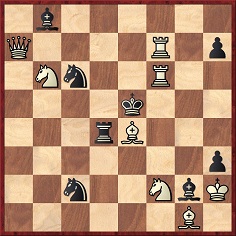
Mate in two
Before proceeding, readers are invited to tackle
this composition, as well as its twin (black knight
on b3 instead of c2):
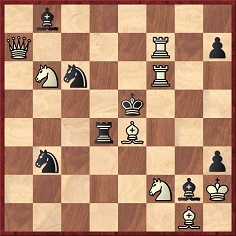
Mate in two
The problem (‘S.G. Voronov, USSR’) appeared on page
582 of the October
1970 Chess Life & Review, in the
‘Benko’s Bafflers’ column. The solutions were given
by Pal Benko on page 643 of the November
1970 issue:
‘1 R-R6? N-K6! 1 B-Q5! Twin: 1 B-Q5? N-B4 1 R-R6!
The deceptive becomes real in the twin.’
Drawing this problem to our attention, Tony Bronzin
(Newark, DE, USA) notes that the first diagrammed
position was taken up on pages 143-144 of the March
1971 Chess Life & Review by a
reader of the ‘Larry Evans on Chess’ column, Robert
Stachowski of Milwaukee.

Mate in two
Concerning the published key move, 1 B-Q5, he
asked:
‘Isn’t 1 R-B5ch an alternate solution?’
Evans’ reply:
‘Right! If 1...K-K3 (1...K-Q3 2 Q-Q7 mate) 2
R/7-B6 mate.’
Mr Bronzin informs us that nothing more on the
Voronov problem can be found until much later. On
page 266 of the May
1976 Chess Life & Review, Benko
wrote:
‘My problem column receives many attempted cooks,
a large number of which turn out to be mistaken.
Of course, problemists also make mistakes. I
obviously cannot publish the wrong cooks, and
apparently some readers do not realize that when
their cooks do not get published it is because
they are not correct. Then they send them
elsewhere. Look at this:
S.G. Voronov

White mates in two
Twin: Nc2-b3
This position appeared in Benko’s Bafflers in
October 1970. A reader suggested that the problem
was “cooked” by 1 R-B5ch. (The published solution
is B-Q5.) I did not publish that “cook”. To my
great surprise, I found the same question in Larry
Evans’s column of March 1971. “Isn’t 1 R-B5ch an
alternate solution?” Evans’s answer: “Right! If
1...K-K1 [sic – K-K3] (1...K-Q3 2 Q-Q7) 2 R/7-B6
mate.”
Obviously the “cook” is cooked: after 1 R-B5ch,
K-K3 is a discovered check to White and there is
no time for mate! At the time I drew the attention
of Grandmaster Evans to his error and waited for
the appearance of the correction. In vain, alas.
It is very difficult to admit a mistake. This is
a weakness of human nature.’
That was the conclusion of a three-page ‘In the
Arena’ article by Benko, subtitled ‘Errare
humanum est’. Two thirds of the final page
comprised corrections of Larry Evans on various
points, and Benko’s introductory paragraph in that
section was:
‘Of course, I am not immune to error, but it
hurts me when someone claims there is a mistake in
my work when there is none, especially when that
someone is a grandmaster.’
This item will be added to our feature articles on
Pal
Benko and Larry
Evans.
12168.
Reviewers
Why do almost all chess reviewers like almost all
chess books?
12169.
Emanuel Lasker in Cuba
From Yandy Rojas Barrios (Cárdenas, Cuba):
‘I have just finalized a 300-page manuscript
on Emanuel Lasker’s visits to Cuba in 1893 and
1906. It is in Spanish, but I am hoping to have
it published in English, in a single volume or
in two parts.
With the advances in AI technology, it is now
possible for me to produce a working English
translation, but to ensure maximum accuracy I
shall need it to be reviewed by a native
English-speaking editor with good knowledge of
Spanish. In addition, I am seeking an
English-language publisher.
As examples of the material that has been
found, here are two reports giving very
different impressions of Lasker:
Andrés Clemente Vázquez, El Fígaro,
Ausencia de Mr. Lasker, 19 February 1893, page
70:
“El Sr. Lasker nos ha dejado convencidos de
sus excepcionales facultades como luchador de
la Escuela Moderna, pero sería inútil ocultar
que su despedida ha sido fría, no sólo por
haberse negado a medir sus fuerzas con el Sr.
Walbrodt, en lo cual había extraordinario
empeño por parte de los aficionados de esta
capital, sino porque en todos casos demostró,
al jugar con esos mismos aficionados, un
implacable sistema de aprovecharse de los más
insignificantes detalles, para ganar a toda
costa. En la primera partida con nosotros, nos
obligó a jugar media hora más después de
habernos eximido de ella previamente, a causa
de una repentina indisposición que sufrimos;
habiéndose debido quizás su postrero cambio de
parecer, al hecho evidente de que en el
instante en que debía haberse suspendido el
combate, la posición era crítica para él, y no
le convenía que con el descanso tuviéramos
mucho tiempo para buscar y encontrar la jugada
con la cual podía perder. Esto no obstante, al
día siguiente le quedaban diez minutos para
hacer nueve jugadas, se presentó en el lugar
de la cita con un cuarto de hora de retardo, y
nosotros no quisimos reclamar la victoria, por
el transcurso del tiempo ... Nobleza obliga, y
la generosidad y la caballerosidad han sido
siempre blasones de nuestra raza. Nosotros
relegamos todo eso al archivo del pasado, y
deseamos al inteligente y joven champion de
Inglaterra [sic] las mayores
prosperidades, en su ya brillantísima carrera,
como jugador de primer orden, en el sublime
arte de Philidor y Anderssen.”
Juan Corzo y Príncipe, Diario de la
Marina, Lasker en la Habana, 11 February
1906, page 5:
“El Campeón del mundo cuenta 36 [sic]
años de edad, aunque representa menos …
Desde su llegada se ha captado Mr. Lasker las
simpatías de los aficionados de Cuba, que no
habíamos tenido ocasión de conocerle cuando
vino a la Habana en 1893.
Siendo una eminencia en un juego eminente, y
poseyendo gran cultura que se revela en su
conversación que puede sostener en cuatro
idiomas, pues conoce perfectamente, a más del
alemán, el inglés y el francés y algo de
español, es modesto y afable, habiéndose
prestado desde el primer día a jugar partidas
rápidas con los jugadores fuertes y dando
partido a los jugadores débiles, siendo para
ellos un franco camarada, a la vez que un
maestro ideal, porque sabe enseñar
deleitando.”’
We shall pass on to Mr Rojas Barrios any messages
from readers about editing and publishing his work.
12170.
Calendar dates
Very few calendar dates have entered chess lore,
despite possible prompting at the time. Page 59 of Anatoly
Karpov: Chess is My Life by A. Karpov and A.
Roshal (Oxford, 1980) has this piece of old-style
second-hand reportage:
‘When Botvinnik heard by telephone that Karpov
had become one of the winners of the Alekhine
Memorial, he exclaimed, according to the person
who informed him: “Remember this day, 18 December
1971. A new chess star of the first magnitude has
risen.”’
12171.
Obvious moves
Wanted: remarks by chess writers (Fred Reinfeld
comes vaguely to mind) to the effect that some
inexperienced players tend to spurn, or cannot
abide, obvious moves.
12172.
Levy Rozman
An addition to Chess
Book
Sales is How to Win at Chess by Levy
Rozman (various editions, 2023). Its status is
demonstrated by exceptionally high rankings on,
notably, Amazon.com and the New York Times
bestseller list. The book has been translated into a
number of languages.
Levy Rozman’s YouTube channel, ‘GothamChess’,
currently has 6.5 million subscribers.
12173.
Keres in Havana
Olimpiu G. Urcan (Singapore) has submitted the
following, courtesy of the Prensa Latina Archive:
The photographs are undated, and information will
be welcome. Our feature
article on Keres includes (C.N. 2628) a game
from a simultaneous exhibition with clocks in Havana
on 9 February 1960. The source was pages 291-292 of
Ajedrez en Cuba by C. Palacio (Havana, 1960).
Addition on 14 July 2025:
Confirming the year 1960, and adding that Keres
arrived in Havana on 6 February, Yandy Rojas Barrios
(Cárdenas, Cuba) forwards from his archives two more
photographs from the visit:
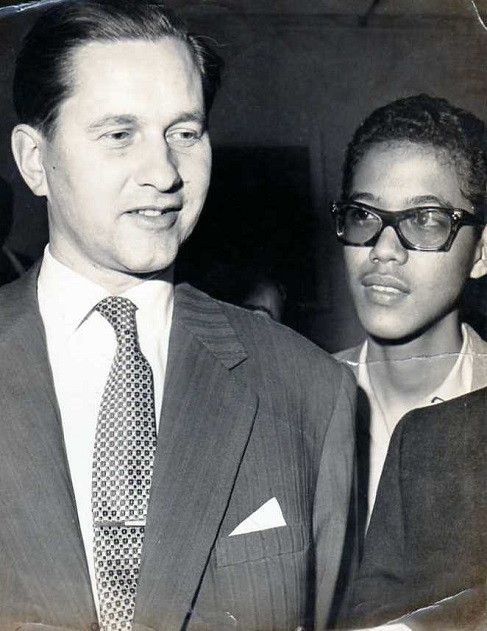
With Eduardo Heras
León (1940-2023), then the national youth
champion, and later a prominent literary figure.
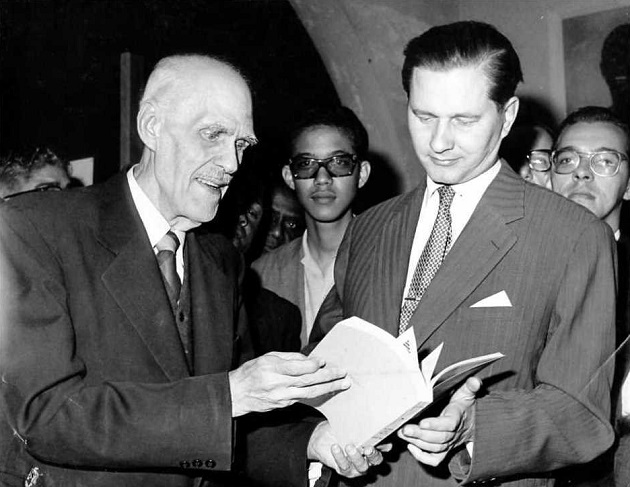
With José Antonio
Gelabert y Barruete (1893-1969).
12174.
Sämisch, Romanovsky and Eliskases
Mr Urcan has also provided this picture of Fritz
Sämisch and Petr Romanovsky, from the Russ-Photo
Archive (a Moscow photograph agency of the 1920s):
It may have been taken during Moscow, 1925, though
it is without relevance to their game in the
tournament.
Lastly, a shot of Erich Eliskases at Mar del Plata,
1947, from the Crítica photographic archive:
12175.
Fischer Defence
Noting the references to Eduard Fischer in The
Nimzowitsch
Defence (1 e4 Nc6), John Saunders
(Kingston-upon-Thames, England) provides a game
between Georg Schories and James Allcock, played in
Plymouth on 31 August 1903:
1 e4 Nc6 2 Nf3 d6 3 d4 Bg4 4 Nc3 a6 5 Be3 e5 6 Bc4
Nf6 7 Qd2 Be7 8 a3 O-O 9 h3 Bxf3 10 gxf3 exd4 11
Bxd4 Nxd4 12 Qxd4 Nd7 13 Nd5 Bf6 14 Qd2 Ne5 15 Be2
c6 16 Ne3 Qc7 17 O-O-O Rad8 18 f4 Ng6 19 Nf5 Rfe8 20
Bd3 b5 21 h4 c5 22 c4 bxc4 23 Bxc4 Rxe4 24 Qd5 Rxf4
25 b3 Be5 26 Ne3 Ne7 27 Qg2 Qa5 28 Nc2 Qc3 29 Rd3
Qb2+ 30 Kd2 Nf5 31 Rf1 Rxc4 32 bxc4 Bf4+ 33 Re3 Nxe3
34 White resigns.
Mr Saunders comments:
‘This clipping from page 3 of the Alderley
& Wilmslow Advertiser, 11 September 1903,
shows a British chess columnist referring to 1
e4 Nc6 as the Fischer defence. The columnist was
given as “Captain King” and was most likely to
have been Carslake Winter-Wood, who resided in
Plymouth, where the game in question was
played.’
12176.
Opening of the future
When was the term ‘the opening of the future’ first
seen in chess literature?
An early occurrence, attributed to J. Crake, is on
page 172 of the May 1883 BCM, with respect
to 1 e4 e5 2 d4 exd4 3 f4.
12177.
Raymond Chandler
Some alleged quotations:
‘Life’s too short for chess’ – Henry James Byron;
‘Chess is a foolish expedient for making idle
people believe that they are doing something very
clever, when they are only wasting their time’ –
George Bernard Shaw;
‘Chess is possibly the only game in the world in
which it is impossible to cheat’ – John Steinbeck.
The Internet is awash with such pseudo-quotes. All
have been discussed in C.N. (see the Factfinder)
and are examples of a practice referred to as
follows in C.N. 9413:
Any colourful approbation or disapprobation of
chess in the output of an eminent literary figure
is liable to be quoted as representing his own
views even if expressed only by a character in a
work of fiction.
Another case will be examined now:
‘Chess is as elaborate a waste of human
intelligence as you could find anywhere outside an
advertising agency’ – Raymond Chandler.
A point of evident indifference to some chess
websites is that the essentials of this ‘Chandler
quote’ have been examined in fine style on a Quote
Investigator
page. It was a remark by the narrator, Philip
Marlowe, in The Long Goodbye, a novel by
Raymond Chandler (London, 1953 and Boston, 1954).
We add that the text was discussed by Montgomery
Major, the then Editor of Chess Life, in D.J.
Morgan’s Quotes and Queries column, in the
November 1957 BCM, pages 294-295:
Below is the relevant part of The Long Goodbye,
with full context, on page 128 of the first US
edition:
The highlighted passage, consisting mostly of one
long sentence, prompts us to underscore Montgomery
Major’s observation about ‘candid criticism of some
grandmaster chess tactics’: the private detective’s
comment about ‘a waste of human intelligence’ refers
not to chess in general but to the 72-move draw
between Gortchakoff and Meninkin.
An earlier Quotes and Queries item (number 181 on
page 154 of the May 1954 BCM) also concerned
Raymond Chandler and The Long Goodbye:
From pages 194-195 of the US edition of the novel:
Regarding the Sphynx problem, our feature article Howard
Staunton includes the brief text of C.N. 1190:
In New in Chess issue 3/1986 the readers’
letters section suddenly comes alive with a series
of excellent contributions on the Sphynx problem
in Staunton’s Handbook.
In 2016 the matter was discussed in admirable
detail by Michael Clapham in his Chess Book Chats
series. See part
one and part
two.
The scans in the present article have been provided
by the Cleveland Public Library. As so often, we are
greatly indebted to Mr William Chase and Mr Raymond
Rozman.
12178.
Bjelica and Fischer
Our article Dimitrije
Bjelica currently has little on his relations
with Bobby Fischer.
John Donaldson (Berkeley, CA, USA) has provided the
following from pages 104 and 128 of CHESS,
November 1970 (extracts from an article by Bjelica):
From page 31 of the New York Times, 28
August 1973:
Can more information be found from, in particular,
sources in Zagreb and Belgrade?
|
